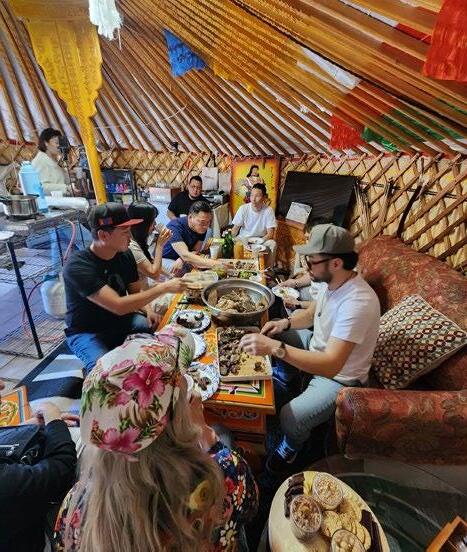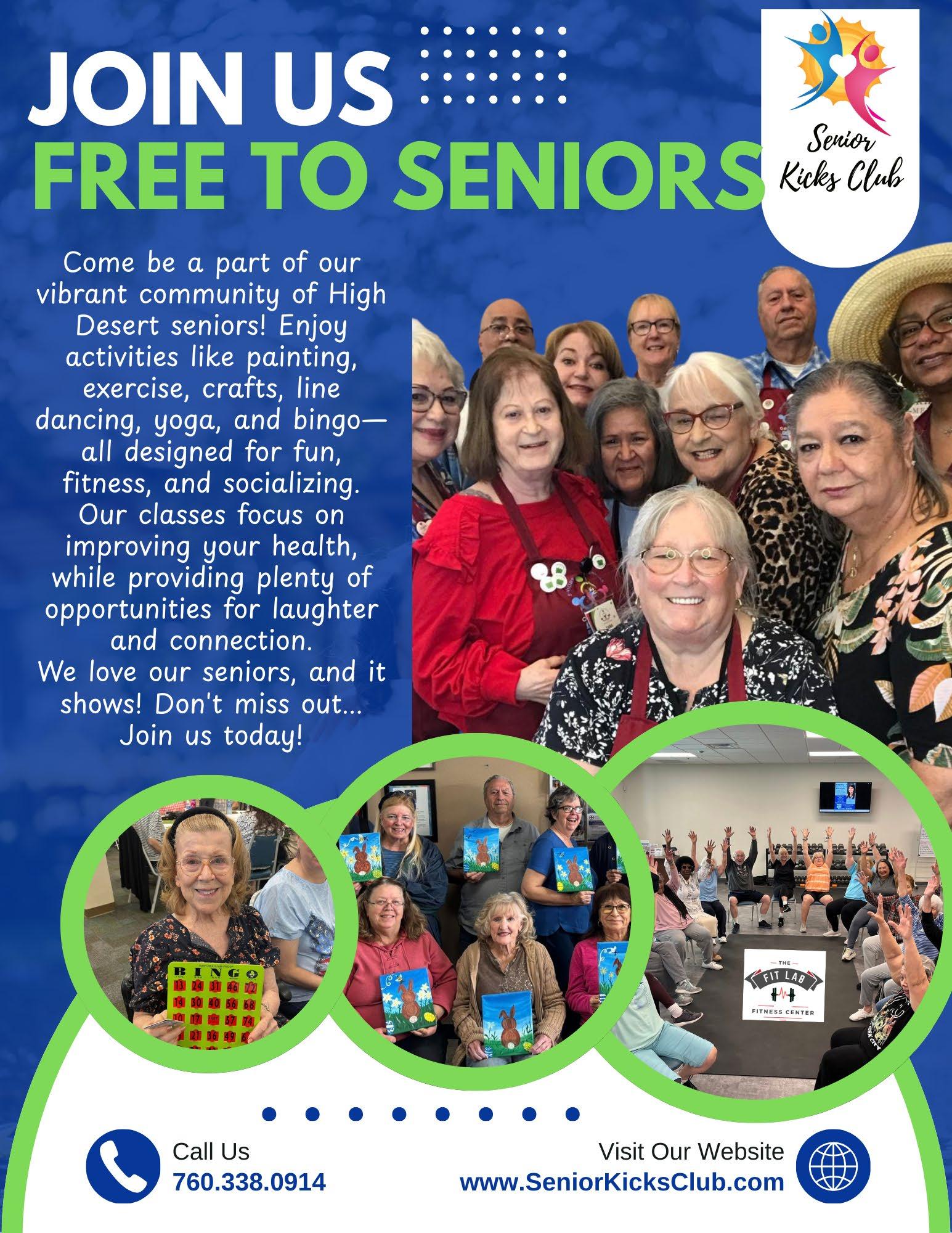




















PRING IS HERE IN THE HIGH DESERT . A time for wildflowers and wild critters to come out. Be extra careful when outside in areas where snakes and spiders might be sunning themselves.
This issue we showcase Travel & Tourism, County Fair and all the wonderful local places for you to visit. Tourism refers to travel for the purpose of happiness or business. More generally, tourism denotes to outdoor activities during holidays at domestic and international levels.
Being our target markets are SENIORS & VETERANS along with our local communities here in the High Desert. Our advertisers, press releases and Events/Calendars are devoted to these markets. One of these groups, is the Senior Kicks Club, check out their ad on the back page and their NEW Senior Discount Card on page 25
We do not have a Letter’s to the Editor section, but we still enjoy hearing from you. That is why the PULSE TEAM members contact info is included on this page. Reach out to any of us and we will respond.
If you are in the Travel & Tourism industry we encourage you to sign up and attend the event in Barstow on May 22nd, see ad on page 19.
HAPPY MOTHER’S DAY to all you WONDERFUL LADIES.
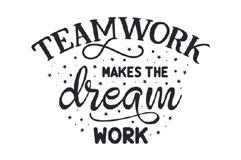



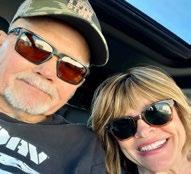
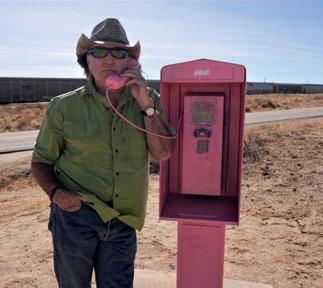
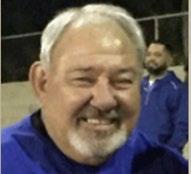


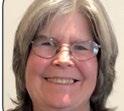

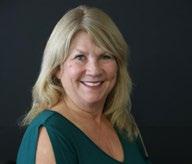
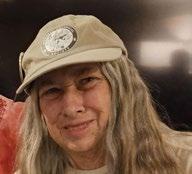

The Downtown Business Association of Barstow is pleased to announce another new business to open soon in Historic Downtown Barstow, at the 201 N First Ave building within the Arts & Cultural District.
Our commitment to the DBA is to provide and promote entrepreneurship for local merchants. Showcase through various public events for talented artists and musicians to enhance our community's quality of life opportunities. How can we provide increased employment opportunities to residents of Barstow? We want to foster increased civic pride and participation.
What can we provide to our local citizens to shop, dine, and visit the Downtown marketplace? Our commitment to the DBA is to provide and promote entrepreneurship for local merchants. Showcase through various public events for talented artists and musicians to enhance our community's quality of life opportunities. How can we provide increased employment opportunities to residents of Barstow? We want to foster increased civic pride and participation.
Simply put, the DBA is "of Barstow," "by Barstow," and “for Barstow.
Simply put, the DBA is "of Barstow," "by Barstow," and “for Barstow.
Work on this site's construction is almost completed. BrewPub Rte. 66 will be next door to the locally owned and operated Crave Kaffee Haus. Once everything is finished and ready to open, the new owners of the Brew Pub will announce the official name of the Tavern.
We live, work, or shop in Barstow, and we are committed to helping Downtown Barstow become the High Desert's cultural and economic center.
We live, work, or shop in Barstow, and we are committed to helping Downtown Barstow become the High Desert's cultural and economic center.
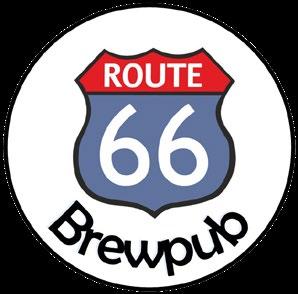
The Brew Pub will be a local long-term resident, businessman, and his partners. Official information will be forthcoming in the next month. They are excited to add this incredible business for the Barstow community and the numerous tourists visiting historic Route 66 and the Downtown Area. There will be 16-plus brewpub beers on tap, many from local area and Southern California breweries. Various bottled beverages, wines, spirits, and the like are also on the menu.
Recent progress and activity sponsored by the Downtown Business Association of Barstow have welcomed a Downtown Coffee house and gathering place, Crave, and a current BrewPub RTE 66 under construction to open soon. The first Annual Arts & Cultural Fest occurred in October 2024, and we are planning a few great events for 2025. There are also other projects forthcoming, and we will update you as these become official.
Recent progress and activity sponsored by the Downtown Business Association of Barstow have welcomed a Downtown Coffee house and gathering place, Crave, and a current BrewPub RTE 66 under construction to open soon. The first Annual Arts & Cultural Fest occurred in October 2024, and we are planning a few great events for 2025. There are also other projects forthcoming, and we will update you as these become official.
The Downtown Business Association is excited to add this great concept to our commitment to rejuvenating the Downtown area to promote thriving businesses to open and operate. Converting and renovating Barstow's old buildings into a vibrant Marketplace to patronize is the incubator for future opportunities to blossom. The BrewPub will be looking to add limited food selections to its menu. Live entertainment, special events, and special theme nights are all on the entertainment stage once open.
DBA is pleased to announce the opening of the new First Ave Bridge in Historic Downtown, a wonderful addition to Barstow. We welcome everyone to come Downtown and see the many excellent sites, murals, Shops, etc., and future opportunities to open a business.
DBA is pleased to announce the opening of the new First Ave Bridge in Historic Downtown, a wonderful addition to Barstow. We welcome everyone to come Downtown and see the many excellent sites, murals, Shops, etc., and future opportunities to open a business.
Barstow is at the crossroads of a bright future with the newly constructed First Ave bridge, the BIG intermodal BNSF facility, which will start construction in 2026, solid groundwork being set for a new housing project, and rumors of a new Junior High and High School (private) in the works. We anticipate positive progress with the new City Manager on board and the new mayor to make Barstow great again.
The Downtown Business Association of Barstow is committed to and actively pursuing great things for the Barstow community. Please join us in welcoming the BrewPub Route 66 to the Community.
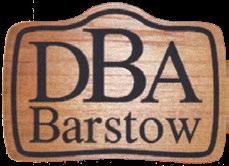

201 North First Ave., Suite B, Barstow, CA 92311
201 North First Ave., Suite B, Barstow, CA 92311
Email: info@downtownbusinessbarstow.org
Email: info@downtownbusinessbarstow.org
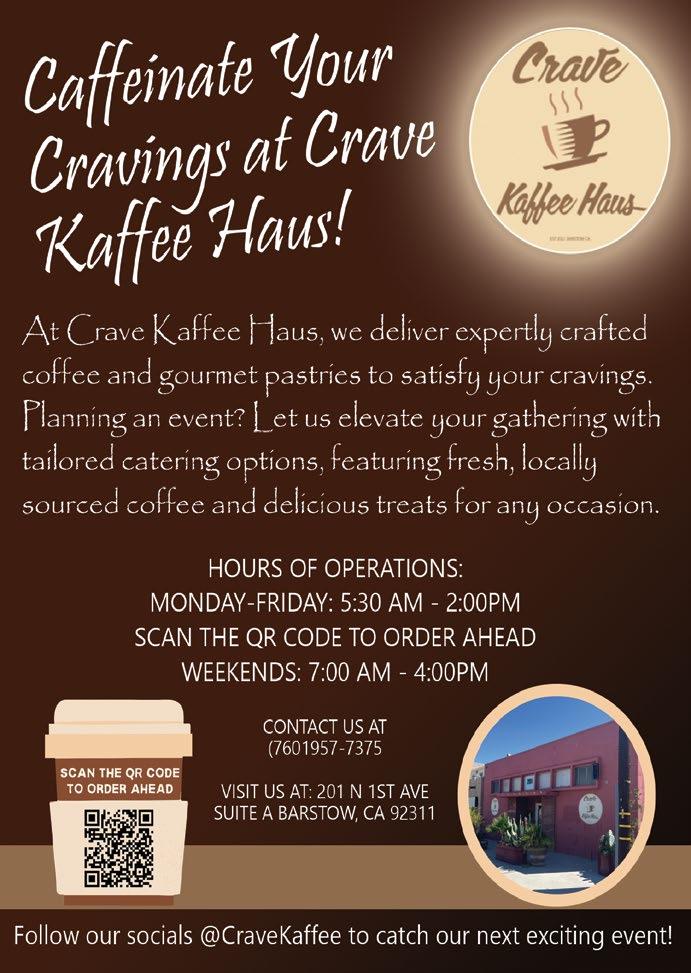
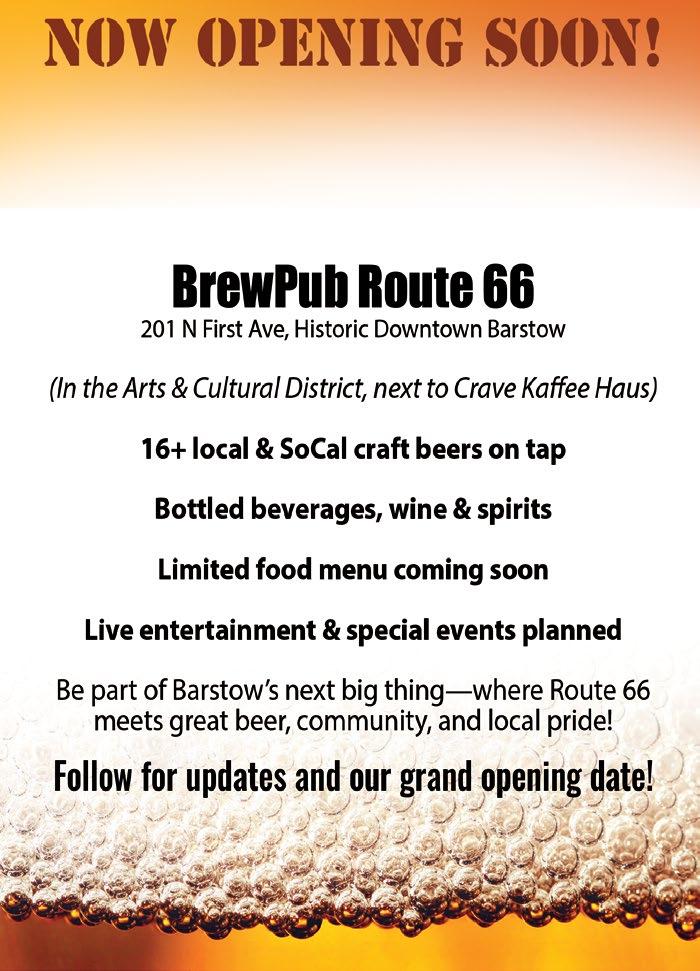
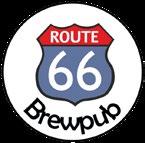
WHAT DO I MISS MOST ABOUT MY FORMER
LIFE now that I’m not able to do it? EXERCISE! No, really! I was athletic all my life. As a child, I loved playing softball in the front yard. When the grass grew, I mowed it into the shape of a baseball diamond so we could have a game. I played basketball on the team at school. And I walked everywhere. As I got older and my children were all in school, I couldn’t wait to get out on my bicycle every day. I rode ten miles in one direction and ten miles back. Some days I played tennis in between. Tennis was a passion. I played several days a week. I could write a piece on all the different courts in the Valley that we played on in the 70’s, from George Air Force Base to various schools, to Apple Valley Inn. But the point I wish to make here is that exercise can be addictive. Until it isn’t. My early morning, five-mile power walks gradually ended, and it got more difficult to make myself get out there. So, when I tell Parkinson’s peeps to exercise, I know it’s easier to ignore. Your bodies are stiffening,
your breathing is a bit more labored, and it’s just plain not appealing.
But - and this is important: EXERCISE can change your life! It can make your Parkinson’s symptoms less imposing. REALLY? Who says? Many doctors and patients say so.
“It is currently believed that if anything can slow the progression of Parkinson’s, it’s regular exercise.” Dr. Bastian Bloem, MD, PhD.
One patient says this: “I cannot state this strongly enough. If a person is truly dedicated to living well with Parkinson’s, he or she must find an exercise routine. There are no medications that can come close to matching the benefits of exercise.”
Dr. Anson Rosenfeld held a two-year study on the effectiveness of cycling. He concluded that cycling may be an ideal mode for people with PD because regardless of disease severity, individuals can achieve and maintain a moderate to high intensity of exercise. I wonder if cycling at a gym might be ideal if one has problems with balance. You don’t get the breeze, but you get the benefit.

by Ann Miner
And, as we say at our support group meetings, the best exercise for you is the one you will do! Walking as briskly as you dare, even using a walker, offers big benefits. Try it. You will like it!!
Meanwhile, remember that we have a special place for you at the Parkinson’s Support Group meetings on the first Monday of every month, 1:00 PM at Choice Medical Bldg., 19111 Town Center Drive, Apple Valley, in front of Jess Ranch. Questions? Call me, 760-954-2859. I love hearing from you.

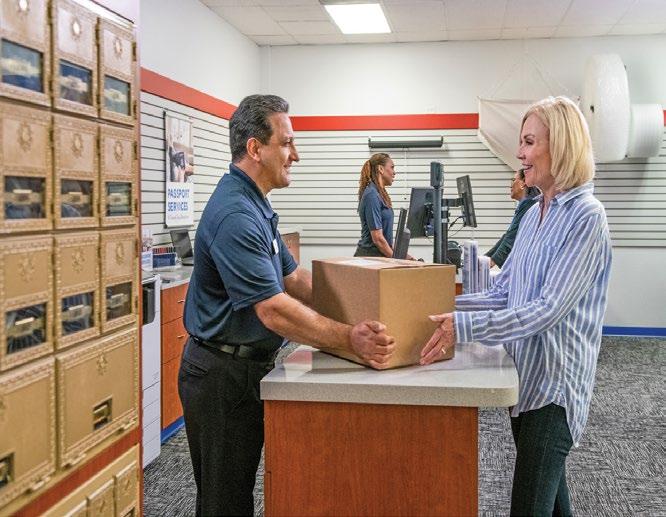
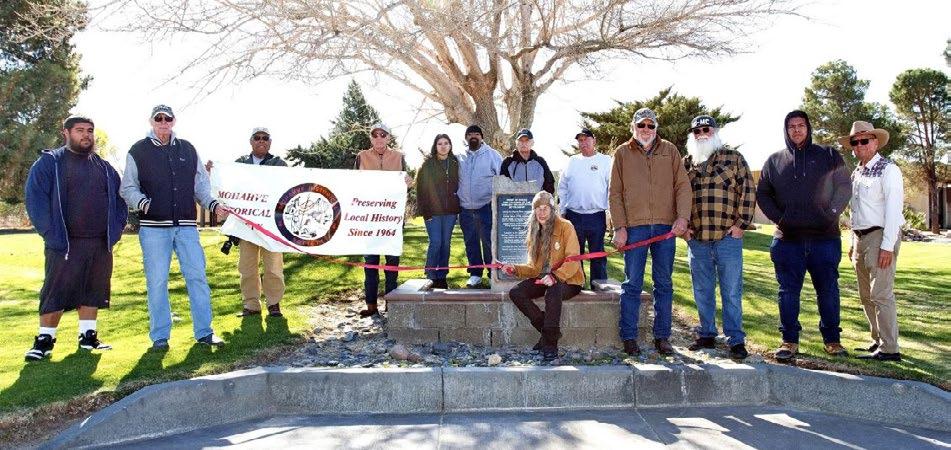
THE SATURDAY March 15, 2025, ribbon cutting in Helendale should be the final step in the Mohahve Historical Society's four-year project concerning our three Heldendale monuments. The ceremony, attended by MHS members, Helendale residents, and members of the Sunsetters Car Club, who lined the street with their classic and antique vehicles, was in celebration of the Point of Rocks monument's new granite plaque and wall repair, sprucing up the entrance to the Silver Lakes Community. When a few MHS members discovered an abandoned monument at Palisades
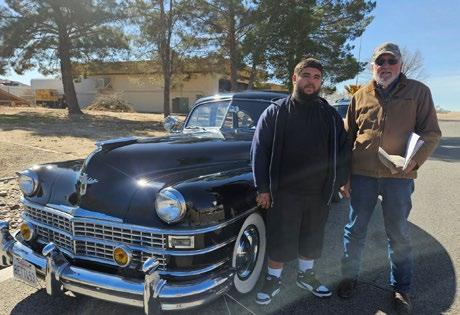
Ranch back in October of 2021, little did we know what it would lead to: digging up and relocating a time capsule, relocating one monument (Palisades Ranch Museum),
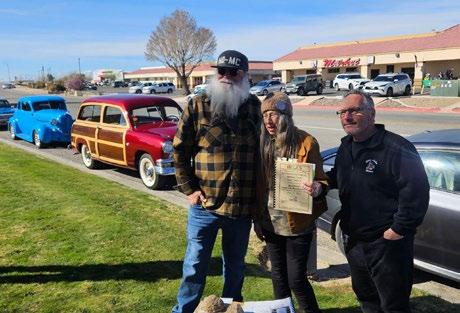
completely rebuilding a second monument (America's Main Street Route 66), and installing a new plaque on the third (Point of Rocks). Once the plaque had been attached by volunteers Jose Gonzales and David Olivas, and the masonry was repaired by the Silver Lakes Association, we were able to complete and publish "Mohahve Historical Society Monuments" Edition 4, now on sale for $10 with three inserts: a map of monument locations, driving tour directions, and a timeline of the history of our MHS monument projects from 1988 through 2025.
To the many strong volunteers (with determination) who donated their time and expertise to complete these projects, I say, "Thank you, and a job well done!"
EXCITEMENT WAS IN THE AIR when seven late 1940's era MG TCs (Motor Guild Touring Cars) with 14 passengers pulled up at the Historic Apple Valley Inn, the site of the TC Motoring Guild's first road trip back in 1955. Just one year after the club's 1954 formation, the maiden trip included a rare photo op at the Apple Valley Ridge, now
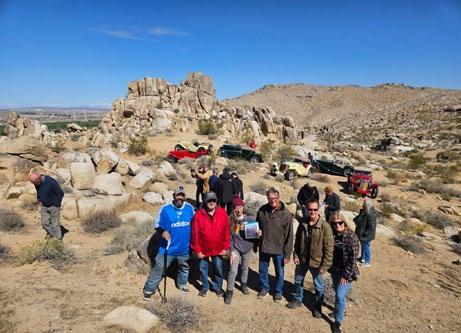
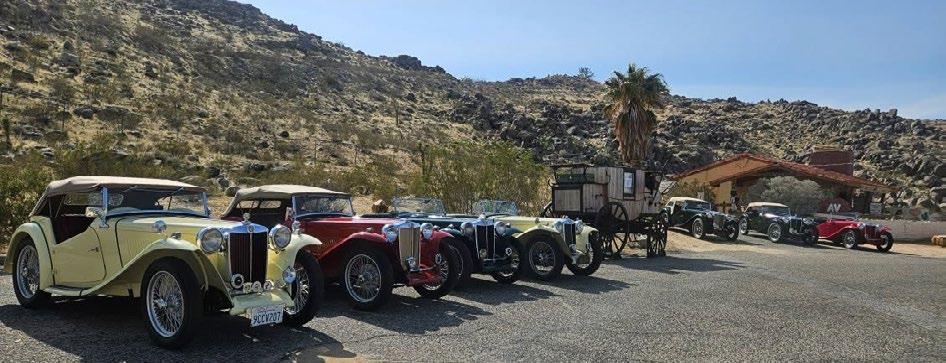
within the boundary of the Apple Valley Ridge Estates, just off Apple Valley Road and Siskiyou. Current Club President Steve Simmons, with the help of Apple Valley Legacy Museum volunteers Bryan and Marcy Taylor, Mayor Scott Nassif, and Councilman Art Bishop, arranged for a re-enactment of the event seventy years
later, but with a few differences.
Instead of breakfast at the Apple Valley Inn dining room, the 2025 group had a tour and local history presentation at the Apple Valley Legacy Museum, Inn Cottage #153. Dinner at Viva Marias followed, and then a good night's sleep at the old Oja Motel, now known as the Apple Valley Hotel and
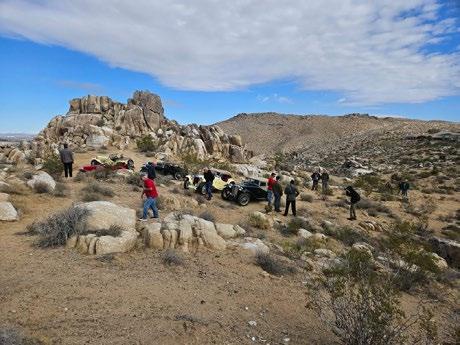
Lodge, on Highway 18 near Rimrock.
The photo the following morning at Apple Valley Ridge, with the beautiful shiny 1945-1949 right-hand drive vintage vehicles, was the highlight of the trip. With help from the 1955 photo, seven cars were strategically parked where the original six had been, with the drivers and their passengers striking poses similar
to the ones on the picture. It is believed that only one photo of the original tour was taken, so the "Daily Press" reporter and photographer, as well as "Pulse" and "Mohahve Muse" newsletter contributers were on hand, making sure there are
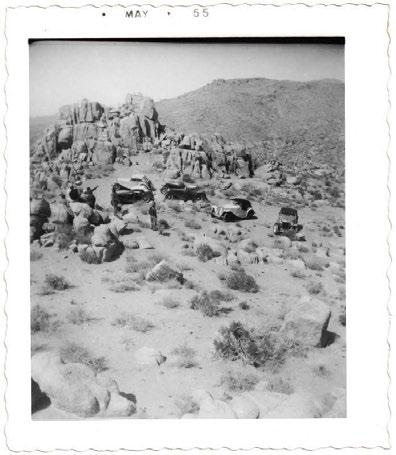
plenty of photos and memories of this year's trip.
With Mohahve Historical Society and Apple Valley Historical Advisory Committee members in attendance, along with our two "homegrown" Town Council members, there is no doubt that this adventure will be remembered as an interesting part of Apple Valley History. Thanks to every one who made the outing possible, and for President Simmons for putting it all together and pulling it off!
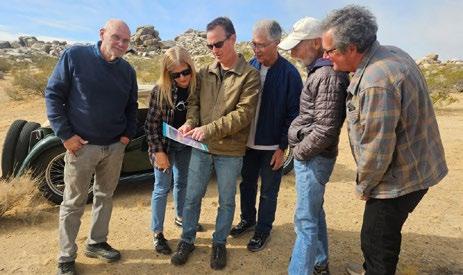
WOW, did 21 Mohahve Historical Society members have a great experience on our Friday March 28 fieldtrip to Morongo Valley. Our first stop at the amazing Morongo Basin Historical Society Museum in Landers, full of displays both inside and out, taught us some unusual facts. Do you know that many weird and sometimes horrible incidents all happen in or near the 33rd Parallel? Why?? Do you know that the dome of the Integratron enables Sound Bath participants to experience rejuvenation and time travel? Why and how?? Do you know why Frank Critzer blew himself up under Giant Rock, the largest free-standing boulder in the world?? Well all 21 members on the trip know the answers now.
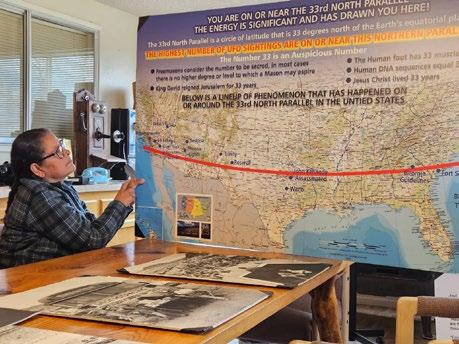
After touring the museum, where our friendly knowledgeable docents James and Claudia Spotts taught us all about the
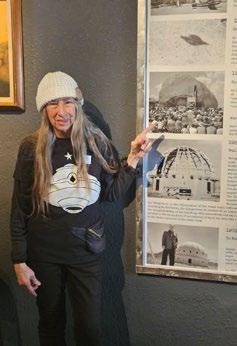
Integratron and Giant Rock, both listed as sites in the book "Weird California, Your Travel Guide to California's Local Legends and Best Kept Secrets," we set off to see both of them up close and personal. Though no one in our group was able to book a Sound Bath the day of our trip, some plan to do so in the future. And who knew that one of our very own members, Kelly Deland, would lead an impromptu tour of Giant Rock, pointing out the former locations of the air strip, the Giant Rock Cafe (whose foundation remains,) the underground
bunkers, and the underground gift shop. He also admitted to attending several Giant Rock UFO Conventions, held annually for 17 years.
Once again, I ask the question, "Who says there's nothing much to do in the desert?" NOT ME!
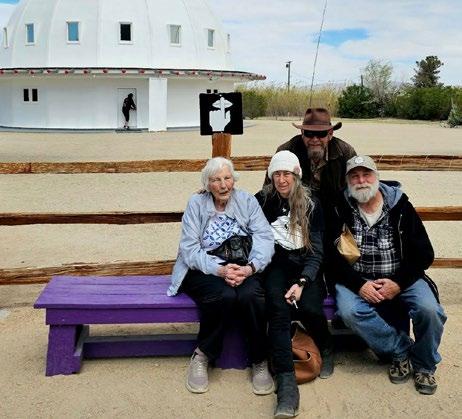
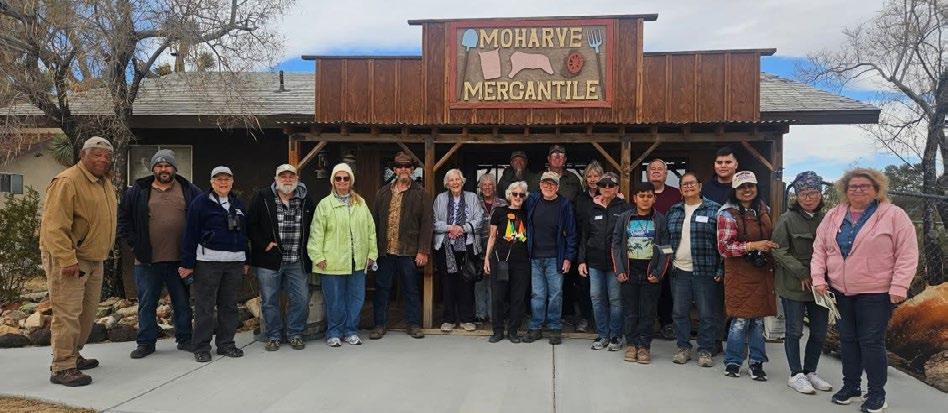
ON SATURDAY March 22, 2025 the Barstow Harvey House, i.e. Casa Del Desierto, was full of excitement, as members of historical societies, Route 66 enthusiasts, and many members of the public celebrated the Grand Re-opening and ribbon cutting of the Mother Road Museum located in the train station. The Mohahve Historical Society, the Apple Valley Legacy Museum, the Victor Valley Legacy Museum, the California Route 66 Association, the Harvey Girls Historical Society, three groups from Newberry Springs, and the City Council of Needles were among the 27 sponsors supporting the Victorville Route 66 Museum's efforts to bring this important piece of the puzzle back to life.
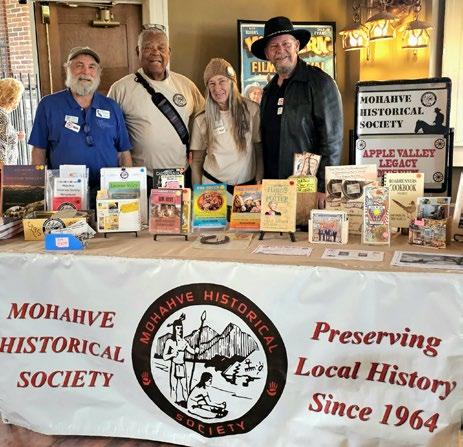

Visitors could browse the numerous display/ sales tables set up in the Ballroom, check out the shiny vintage cars in the parking lot, grab a bite to eat, snap photos with the Route 66 Queens, and witness the cutting of the thick red ribbon with the official oversized scissors.
Oh, and the robot dog running around doing cute dog-like things was also a big hit.
Thanks to MHS Board Members Delvin,
Eric, Mike, and Marcy for manning the table and greeting guests, and to the other MHS members present in support: Meera, Nesha, Griz, Shelly, Richard, Josh and family, and Cheri. And a great big thank you to Brandon O'Brien,Leila Aquino, and crew for taking on the responsibility of renovating the museum and restocking the displays, and to Lynne Miller of the Route 66 Association for pulling it all together. "We're on the road again!!!"
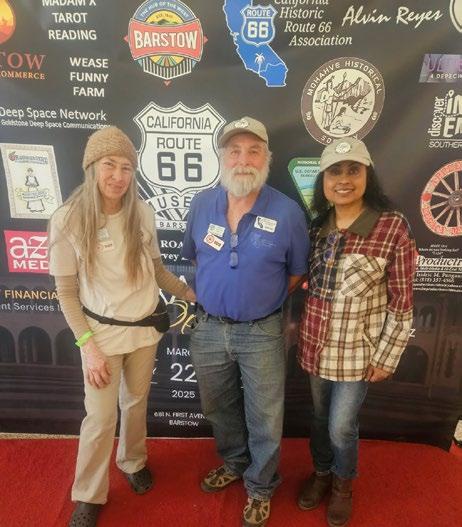
OUR VERY OWN TALENTED AND ACTIVE Boni on the Keys (i.e. Bonnie Ingram), our newest member of the Nonagenarians, celebrated her 90th 3 or 4 or 5 times, with family, friends, and fellow musicians. MHS members and Apple
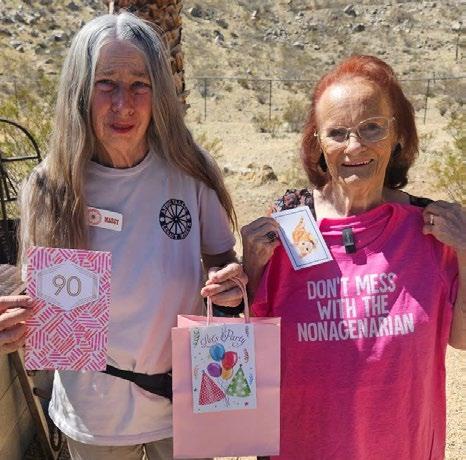
Valley Legacy Museum volunteers were honored to celebrate with her. Bonnie even provided the entertainment at her own party. You go, Girl! Keep on hitting those keys and spreading the love!


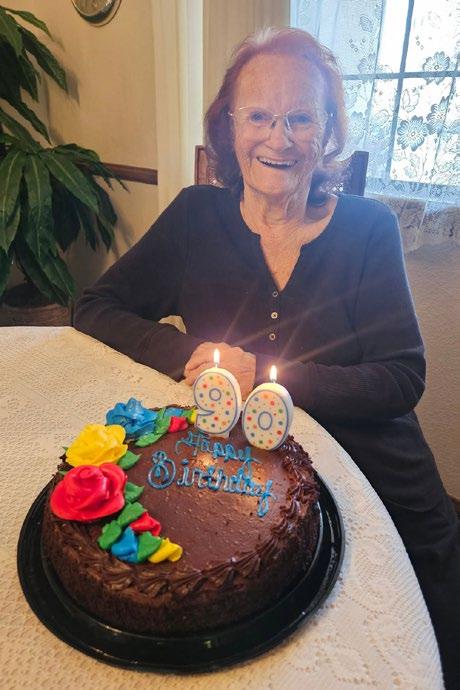
THE VICTOR VALLEY
WOMEN'S CLUB, founded in 1925 by Elizabeth M. Wilson, was a civic minded organization intended to direct community planning in the best interest of families. Our local club is linked to the San Bernardino Federation of Women's Clubs, the California Federation of Women's Clubs, and the General Federation of Women's Clubs. Early VVWC projects included contributing to the opening of the Community Center, the Library, and the Hospital, as well as the naming of Victorville streets.
Ongoing projects support education, home life, the arts, conservation, public and international affairs, and important


special projects. A very visible example is the huge tortoise sculpture at the Victor Valley Museum.
I was honored to speak at the Tuesday, March 18, monthly meeting to celebrate Women's History Month and the Victor Valley Women's Club's 100th Anniversary. My brief bios of 18 prominent Victor Valley area women, of various ages, races, and nationalities during the 1890's to 1960's era, was accompanied by a table display with photos and other momentos representing the contributions of each. Following my talk, "Golden Girl" Anna Maria English was recognized for having been an active member for 50 years. She shared the history of her involvement, and
Aher 5 decades of service.
The club's packed agenda included a review of recently completed events and projects, reminders about current projects, and a preview of a number of future projects. And did I mention the meeting included a delicious buffet lunch with a number of tasty desserts, as well as Anna Maria's beautiful cake. Trust me, no one went away hungry.
Keep up the good work, ladies. The community truly appreciates you!
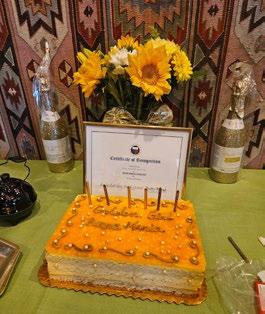
S YOU KNOW , the mission of the Mohahve Historical Society is to preserve and share local history. So in preparation for the Apple valley Legacy Museum's 10th Anniversary celebration, some energetic MHS volunteers, armed with shovels, rakes, and trash bags, hammers, saws, and wire cutters, tackled the long neglected coop of the famous Apple Valley Inn's Pigeon Telephones. These well-trained birds reported for duty opening day of the Inn Thanksgiving 1948. They provided a much needed service for guests in desperate need of a cocktail or a bite to eat, way
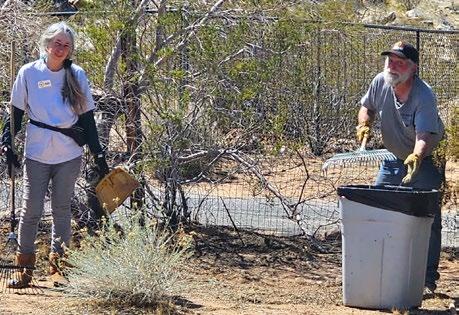
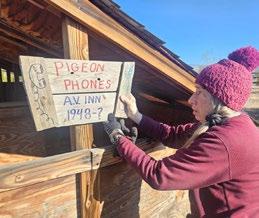
out in Apple Valley far from Victorville and phone service.
Thanks to members Dennis, Delvin, Eric, Kellie, Ralph, Bryan and Marcy for a job well done. We were proud to show off our pigeon coop, an important stop on the narrated historical hayride. Happy Trails!
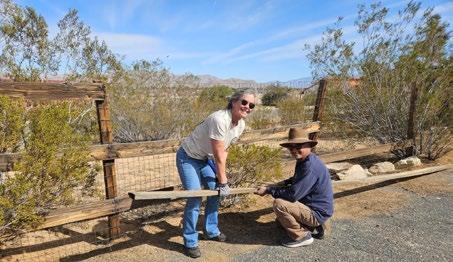
• Every Thursday night (May 1,8,15,22,29) 6-8:00 PM- Concerts in the Courtyard, Apple Valley
• Sat. May 3 10-4:00 Mojave River Valley Museum BBQ, museum visits, displays, sale items, live music
• Sat. May 10 10-4:00 Santa Fe Trading Co. Crafts Fair- Old Town Victorville- booths, live music, museum visits
• Tues. May 13 - Friends of the Apple Valley Library- 11:00 AM - speaker Barbara Betterley - "Betterley Foundation"
• May 24, 25, 26, 30, 31, June 1- San Bernardino County Fair 2-10 PM - Pulse Magazine/ Apple Valley Legacy Museum booth
• May 28 Mohahve Historical Society meeting at Lone Wolf Colony- Anne Roarke "Car Races to Big Bear" doors open 6:30 for 7:00 meeting
By J.P.Garner
DIVERSE TOPICS. Dynamic speakers. And the perfect venue coupled with awesome treats provided by local restaurants were found at Victorville’s First Assembly of God church in the annual Ignite the High Desert event last month.
The event, hosted by the Greater High Desert Chamber of Commerce, has been bringing together, as they describe it, “movers, shakers, creators, thinkers, innovators, doers, and dreamers, in an energized setting meant to motivate,” since 2015 . . . and the 2025 edition of its unique and engaging format did not fail to please the many residents in attendance.
The speakers compress their passions, projects, beliefs, or life stories into 5-minute presentations, which are enhanced by 20 PowerPoint slides that automatically change every 15-seconds. It was fastpaced and energetic which excited, delighted, and inspired the people seated in the darkened sanctuary.
The best of which might
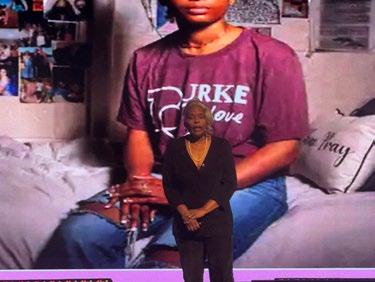
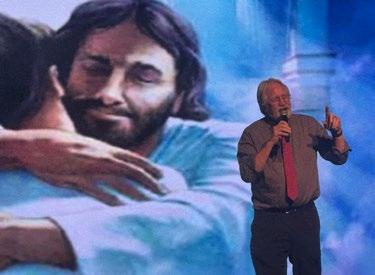
have been the High Desert’s answer to Elon Musk in 13-year old Josiah Melesio, a homeschooled entrepreneur, who took up 3D printing at the tender age of 10 and now runs his own business. Or, consider high school junior Mariana Strong who uses her hobbies to develop the skills she will need to become a neurosurgeon.
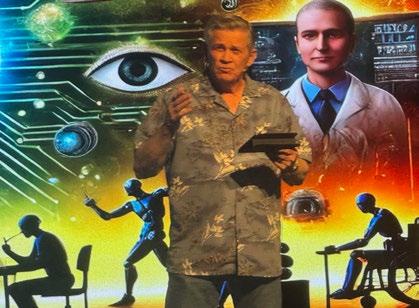
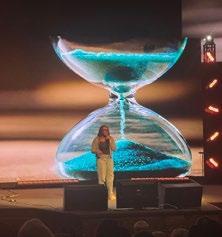
Youth was definitely served but so too was youth a concern when Joan Rudder Ward, an award-winning visual media expert, addressed the “negative effects of unrealistic beauty standards” our youth deal with everyday on social media. From Ai to local organic food production, and to water conservation and how to “wing it” when you’re caught unprepared, the subjects of discussion were varied and expertly conveyed to an enthusiastic audience.
Ignite the High Desert was—and is—a joyful and electrifying excursion into what we as a community of dreamers, risk-takers, and visionaries can achieve when banded together and pointed to the future.

SHE RAN TRACK IN HIGH SCHOOL. The 50-yard dash and the 440 relay. She was really fast and could beat most boys in a 100-yard race. She didn’t join any clubs but she was good at English, especially spelling. She always got A’s in that class, but her favorite class was PE because she got to play multiple sports. Most of the time, though, she hung out with friends and, when she watched TV, it was the old stuff on the off-channels like Gunsmoke. Gunsmoke . . . really?
In her defense, she also watched The Dukes of Hazard and I Dream of Jeanie but you’d think that an exceptional romance writer like Laura Mills would have bingedwatched Peyton Place or something like it . . . a heart-tugging day-time soap maybe, but it was a book her mother bought her when she was eleven that got her started.
“It was called The Silver Kiss by Lynn Erickson,” Laura explains, “and it’s about mining silver in a Colorado town. I never forgot it and I actually ordered it again because I had lost it a long time ago but I have it now. And that was the first [romance] I ever read. When I got older, I started reading more.”
She started writing when she was eleven years old. “Stories would pop up in my head. I’d see a woman in a magazine and think of her as a female character for a story scene playing in my head. My first story was a hundred and twenty thousand words. Over a couple years span. It was about horse racing. I’ve always loved horse racing and at the time it was more popular in England so [the story] takes place in England.
“I watched Pride and Prejudice to get the language to use for the characters. That was really helpful. And it’s about a girl who wanted to horse race even though it wasn’t allowed. The hero was a trainer and a lord. I sent it to Writers Digest to

be judged, and I never won but Jane Friedman from Writers Digest said [the book had] excellent characterization and an excellent plot.”
She admits she’s not a “school” person, so she never went to college for writing, but she always has liked to write. Her husband had a machine shop and she helped him full-time, so it wasn’t until 2015 that she wrote a second book, And now, she laughs, “I’m on a writing spree. I’ve written five books, and when I submitted book number three, A Brother’s Promise, to the Global E-Book Awards competition, I won Gold for best historical romance. That was in 2018.”
A Global Ebook Award is more than an honor for the best ebooks published. It is high recognition and high-profile publicity for ebook authors. The ebooks are evaluated by judges who are experts in their category and who love their genre. The Gold Medal is the highest of the awards offered.
A member of the High Desert branch of the California Writers Club, Laura says,
by J.P. Garner
“I’m very motivated right now and have a lot of stories I’ve written ideas down for. I write [mostly] from inspiration. A Brother’s Promise came from a Bible verse in Deuteronomy regarding the Levite law. The hero’s brother died and he basically asked him to marry his wife to take care of her. And I went from there.
“Instead of getting an agent, I have decided to self-publish. I’m kind of a control freak as far as I want to be in control of every aspect [of my book.] Right now, I’m writing my sixth historical romance, and I’m a quarter of the way through. I also have one contemporary romance in mind. I also [want to write] an action-adventure romance fantasy series. It includes five books and I have about fifteen thousand words written in book one so far.”
When asked who is her favorite author, Laura said Catherine Anderson. Then she added Samantha James. But the thing that will surprise—and please—any reader of Laura’s books is not only the elegance of her writing and attention to detail, but her skill at storytelling. She has learned it is one thing to write a story, but it’s something else entirely to tell a story.

By John Beyer
ONE NICE ASPECT TO VISITIN g a museum that you have not been to before, is that you are a newcomer.
Nothing is expected of you.
“Welcome to the Norton Air Force Base Museum,” the friendly female docent said to me as I entered through the double glass doors. “Is this your first time to visit?”
Nothing was expected of me, but I truly thought there should have been.
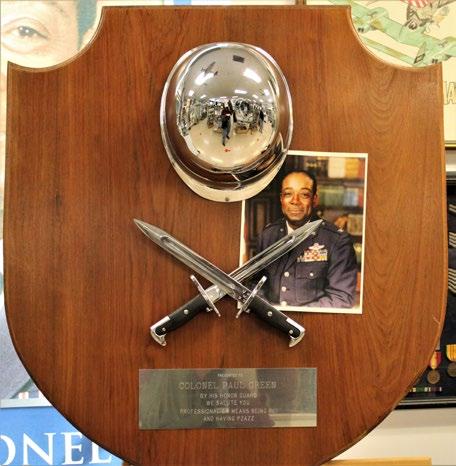
“No, in fact my father was stationed here in the sixties, and I make it a habit to visit the museum to remind me of the times I came out to the base with my father as a young boy.”
I wish I could have replied that. I could not. It was my first visit to a museum that opened in 2013 on the very base my father, George T. Beyer, served until his retirement from decades serving in the United States Air Force.
“My first visit.”
Docent JoAnn explained, “We are a small boutique museum. But we are filled with a lot of memories of both the men and women who not only served at Norton, but all those from around the world who found themselves here for a long or a short period.”
It is a small museum. One large rectangular room filled to the rafters with every sort of memorabilia a lover of military history would find enthralling.
Of course, the room did not have rafters but instead featured a drop ceiling which had been replaced when the concept of the museum came to fruition in 2012. Prior to that year, the entire building, not just the museum, had been neglected for years.
“It used to be the NCO club,” Docent
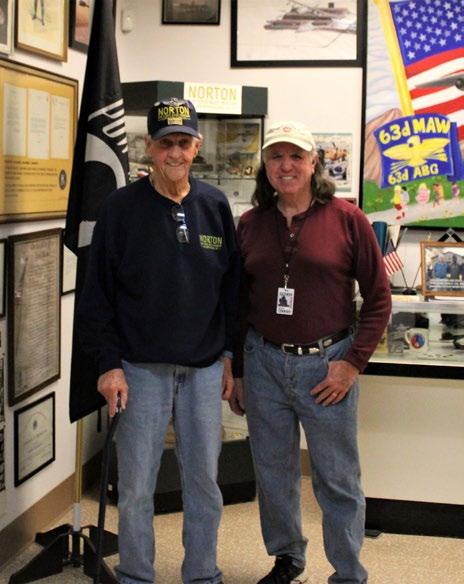
Dudley stated. “I understand this place had a lot of visitors through the years.
Docent Dudley would know. He had been a flight engineer before retiring from the Air Force, and served at Norton AFB from 1973 until 1982.
I wondered for a moment if my father had straddled a stool sipping a cold one after work on a hot summer day when this was the NCO club.
The image of him swapping stories with other like-minded fellas, grabbing a few cold beers at the bar seemed a real possibility.
It made me smile.
Docent Dudley would be my tour guide. A nice thing about a boutique museum, such as Norton, a visitor gets their very own guide.
This Docent Dudley, was a fount of knowledge of everything Air Force to

pretty much everything else.
At the end of the tour, I was so impressed about his knowledge, I asked if he knew the winning Lotto numbers for the next drawing.
“I do,” he said. “But I can’t tell you –state’s secret.”
He led me to a rather large display concerning Lt. Col. Kathy La Sauce.
“Have you ever heard of her?” he asked.
I was going to mention that I hadn’t but was a fan of certain bearnaise sauces, but figured this was not a moment for levity.
“She was in the first group of female airplane pilots who graduated in 1977 in the Air Force. She eventually became the first woman aircraft commander at Norton.”
“That’s very impressive,” I replied, while looking at La Sauce’s flight suit which is on display, as well as about a billion awards earned by her.
“Not only that, but she was also inducted into the Women in Aviation, International Pioneer Hall of Fame in 2016.”
This revelation called for a little more research. I soon discovered that La Sauce was the first woman to pilot a C-141 Starlifter. That is one big plane and anyone who could pilot such a beast is a stud or studette.
I have trouble with my golf cart.
I also discovered that Norton used to have flights to Antarctica.
“I guess the NCO club needed a lot of ice,” I said.
Docent Dudley just rolled his eyes. “No, we have research stations there and needed to resupply the people living there.”
I nodded.
“The last trip was in 1992, and the base officially closed in 1994.”
There is a great black and white photo of the crew of that last flight. All were smiling ear to ear – a caption below the photo stated, ‘At last we don’t have to freeze out butts off anymore.’
I might have made that part up.
Norton Air Force Base was named after a true hero and local boy, Leland Francis Norton. He was born in 1921 in San Bernardino, and as Docent Dudley explained, Leland was a man’s man.
Handsome, athletic, great sense of humor, women loved him – for a moment I thought Docent Dudley was talking about me – but I digress.
Leland always wanted to give more than he received and when World War II
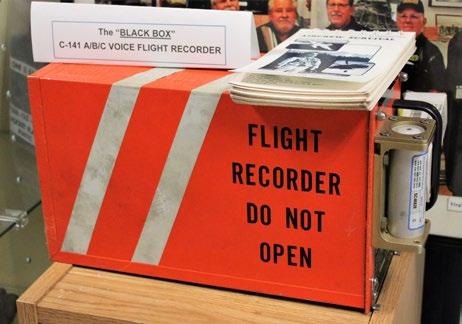
broke out, he joined the Royal Canadian Air Force. At that time, 1941, a pilot had to have at least one year of college, Leland did not. But that was not the requirement in Canada.
In March of 1942, Leland joined the U.S Army Air Force (it was still under Army control) and due to his bright mind and knowledge of flying, he quickly moved up the ranks.
On May 27th, 1944 while flying a A-20 Havoc plane – a twin engine bomber –Captain Norton led a raid against a German railroad yard near Amiens, France. His plane was struck by anti-aircraft fire and even knowing his plane was doomed, Norton kept it flying long enough for most of his crew to parachute out. As the wings and rest of the plane were coming apart, Norton and his bombardier finally bailed out very close to the ground, but as they landed, so did the plane not far away and the unexploded ordinances blew up, killing Norton and the bombardier.
The base that Norton had grown up near was named after him on March 2, 1950.
Next, I was shown a Geiger counter.
“It was used by the pay load guys to make sure nothing being loaded up on the transport planes was radioactive.”
A lot of follow-up questions came to mind, but being on a military post – I probably did not have the need-to-know.
And now comes Docent Chuck, who joined Docent Dudley and me.
“We’d love to have a flight simulator for the kids,” Docent Chuck said. “To get the young ones interested in the Air Force and all the opportunities they offer.”
I am in full agreement. Military service is a very honorable thing and I have nothing but the utmost respect for any service members.
Though my father and uncle served, I never served in the military. My mother
begged me not to join after my uncle was shot down and killed during the Viet Nam era, so I became a cop instead.
But serving your community or country is a wonderful thing.
“There should be a lot of things here for kids to enjoy,” I suggested.
“And more room,” one of the Docents mentioned.
Come on, Air Force – give us a little more room!
Docent Gail joined us and explained that it was a hit and miss in even opening the museum in the first place. There is the very large March AFB Museum, but the Norton Museum seems like a poor second cousin.
“March, can we have a plane throttle?”
“No controls for you!”
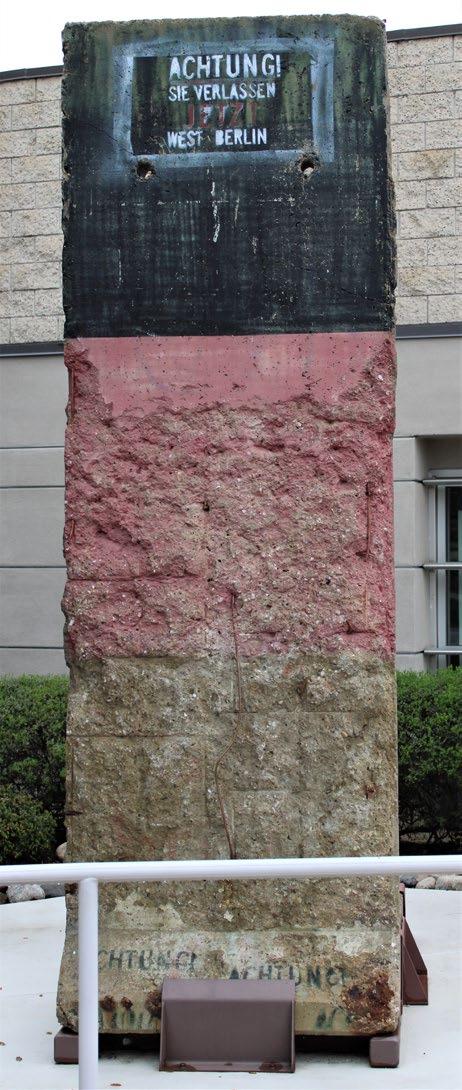
In fact, I was told that the tall missile out at March once belonged to Norton. Since Norton closed, the missile was moved over to the March location. And when the Norton museum opened in 2013, they asked to have it back.
“We’ll send a couple of fire nozzles with Norton etched in them. And you’ll be happy little shoeless cousin.”
In all transparency, both museums get along wonderfully, but I had to just write that.
Docent Chuck told me that Amelia Earhart once landed at Norton in the need of gas.
“Did they give it to her?”
He just looked at me.
“What Amelia wants; Amelia gets.” And she paid for it with an autograph, In truth, she offered money but her little old signature was what the folks wanted.
By now the tour was just about over and I could not tell one Docent from the other. They were wonderful, informative, and knowledgeable, but my pen had run out of ink.
I kept scribbling, never letting on.
“Did you know we had one of the Tuskegee pilots as our base commander from 1974 until 1976?”
Colonel Paul L. Green was a Redtail during World War II. He was and is a legend. An entire wall is in his honor, should be an entire museum for his heroics and service, but the museum is small and his history is large.
Norton AFB Museum is a must see. That is, if the visitor is thankful for the service and sacrifice all these military stars contributed to our country.
Just saying.
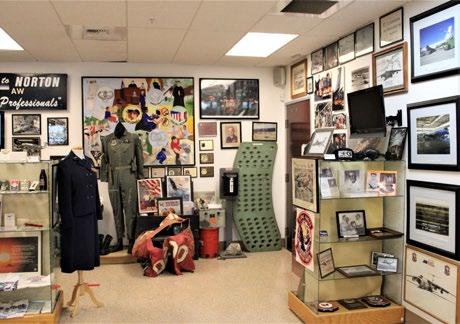
For more information, visit https://www.nafbmuseum.org/




Care and Comfort In A Familiar Environment
Patients receive care in the comfort of their own home, surrounded by loved ones.
Personalized Care
Our team of healthcare professionals establish individualized care plans tailored to the specific needs and preferences of the patient and family.
Emotional and Spiritual Support
Our team of healthcare professionals provide emotional support, spiritual support, resources, guidance and bereavement to patients and their families.
Family Involvement
Family involvement allows loved ones to participate in the patient’s care to maximize what’s important to the patient and focus on quality of life.

18484 Highway 18, Suite 285, Apple Valley, CA 92307 760.536.5658 | info@carelifehc.com | www.carelifehc.com



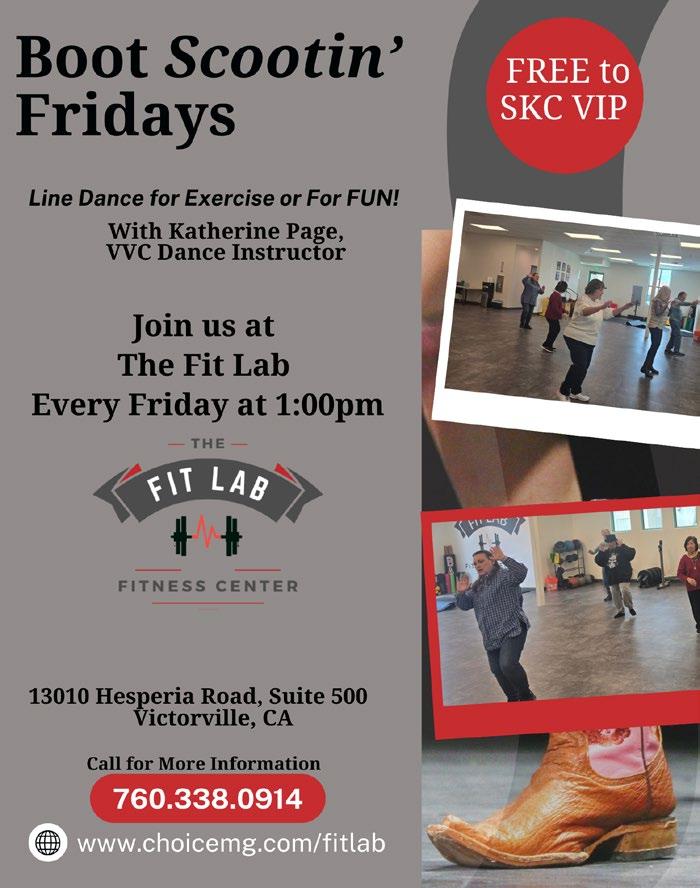

















































HOT RIDES, BEAUTIFUL WOMEN, COOL MUSIC, AND CHILL VIBES! People of every color, background, religion, social status or political affiliation, all in one place!
Where could you find a place like this?
The “American Car Culture” scene!
What is the American Car Culture?







For decades automotive enthusiasts have embraced cars as a representation of freedom, independence, adventure & an extension of their own personality.
Cars have become for some, a symbol of their social or economic status & for others a glimpse at their passions or heritage.
From Racing to Lowriding, Off-roading to drifting, cruising to just collecting, the “American Car Culture” brings millions from different backgrounds, together with one common interest.
However, cars aren’t everything!
Show cars have been coupled with entertainment, music, models, pinups, as well as nostalgic styles, fashion & merchandising. It has become a lifestyle for people not only in the U.S.A. But all over the World.
The next time you find yourself a little lonely or bored, reach out to local auto enthusiast groups. They always have something to do & places to go & meet new friends!
I recommend connecting on Social Media sites, reading up on Car Meets & Car Shows in publications such as “The Pulse,” or reaching out to a local Car Club.
Many automotive events have become collaborations with nonprofit organizations, schools, small businesses & entertainers.
Car Shows have become part of larger community events and fundraisers for different causes.
They are also a way to inspire and motivate today’s youth, with career planning within the automotive industry.
Join us in celebrating the hard work, money & skill that go into these amazing machines & become rolling art & preserved pieces of our Human History.
Visit “Inglis Classics” on Facebook or Instagram to submit a

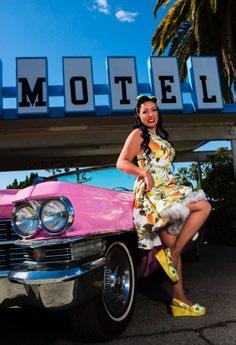










picture of your ride & why it should be featured in “The Pulse Publication” and you might see your work of art on display! See you next month at “The Pulse!”
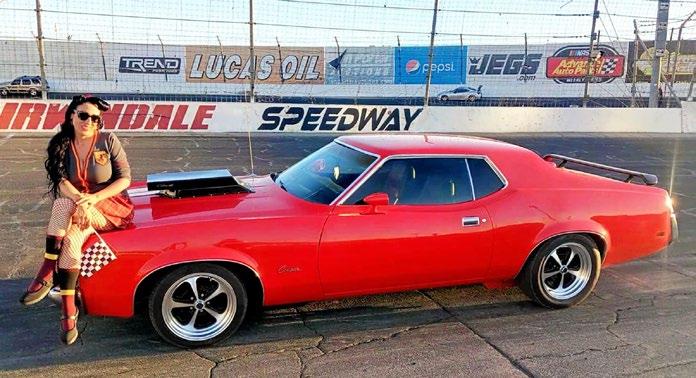
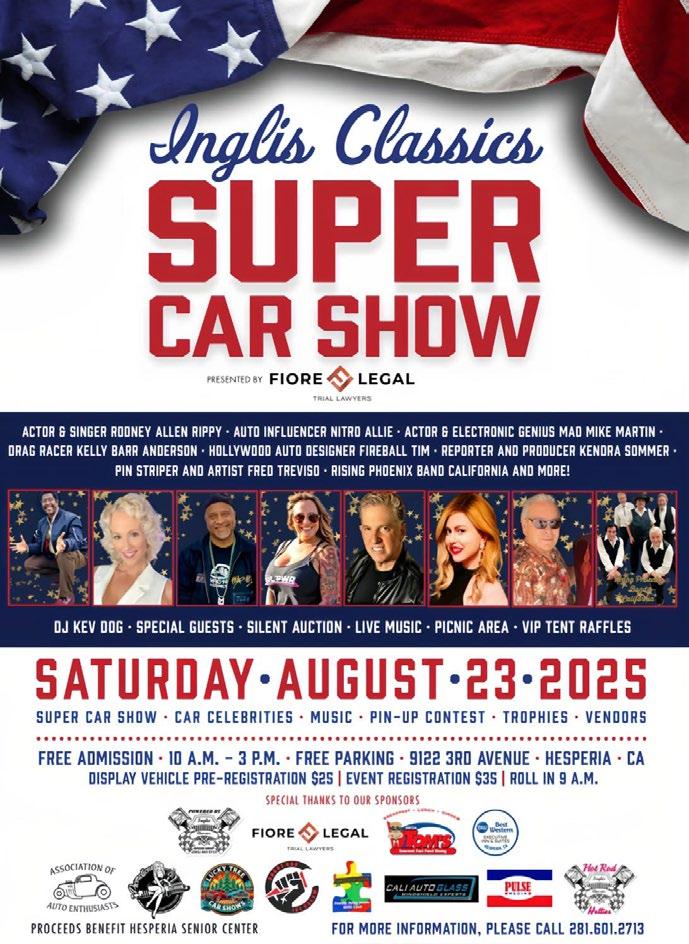
By Jaylyn And John Earl www.thedesertway.com
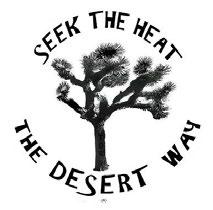
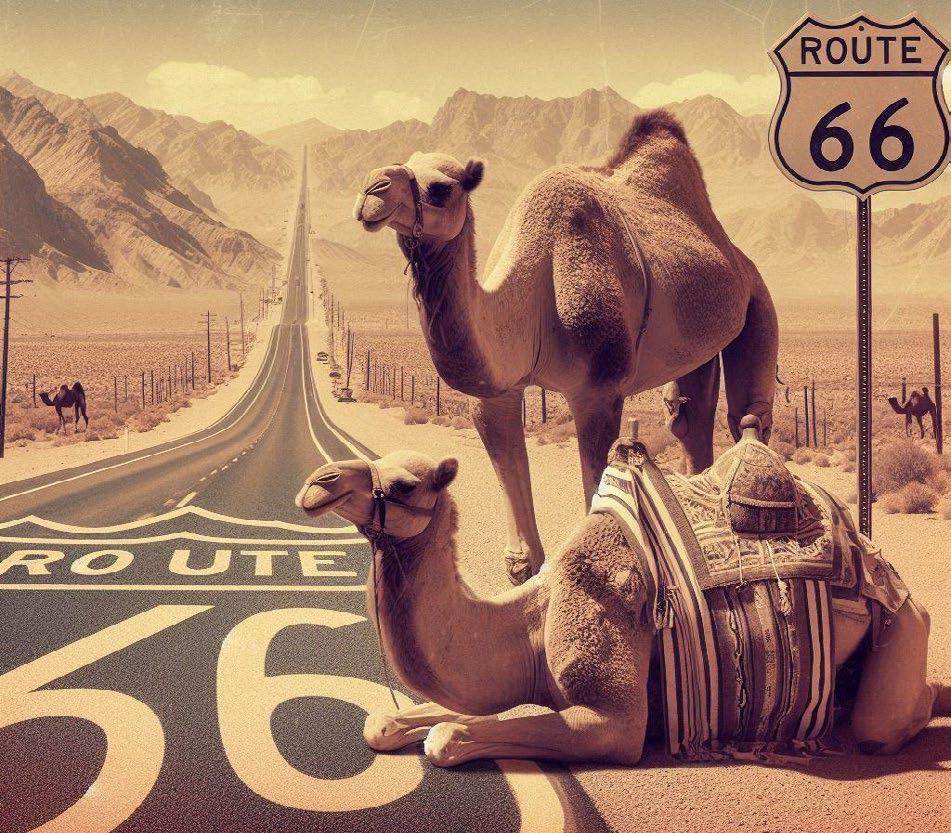
IT WASN’T CAMEL CIGARETTES that paved the way for Route 66, although that would come later with its billboards and imagery appearing along the iconic Mother Road.
It was living, breathing dromedaries (one humped) camels and Bactrian (two humped) camels acquired from Turkey, Egypt, and Tunisia.
A persistent legend of the Southwest is the camel who roams the deserts.
From Banning, California, to San Antonio, Texas, weary prospectors far from civilization tell of a great red camel or an ancient white one, still wearing a leather Army saddle.
Sometimes the camel has even been seen with a ghostly rider, a skeleton lashed to its back, moving across the sands into the distance.
Behind the legend there is some truth, and the yarns swapped around the desert campfires are based on actual happenings.
In 1851 Joseph Warren Fabens wrote a

novel which became very popular, called The Camel Hunt, in which he described an imaginary expedition to Algiers to import camels for use in California. Fabens especially emphasized the swiftness of the camel.
Mississippi Senator Jefferson Davis (who later became President of the Confederacy) had been trying to interest Congress in his camel scheme for four years.
As chairman of the Senate Committee on Military Affairs in 1851, he proposed that the War Department’s annual budget carry an extra appropriation to import thirty camels and twenty dromedaries of various breeds, together with ten Arabs familiar with their habits, and try them out in the deserts of the Southwest.
But the senators greeted Davis’ proposal with laughter. Most had never been to the Southwest deserts nor seen a live camel.
To them, the ungainly, long legged beast was a menagerie attraction fit for a circus, not army equipment.
The lands acquired in the Mexican War included all of California, Nevada, Utah, Arizona, and the western parts of Colorado and New Mexico, embracing the area of 529,000 square miles. It required serious desert transportation.
The discovery of gold in northern California in 1848 gave great impetus to the westward movement.
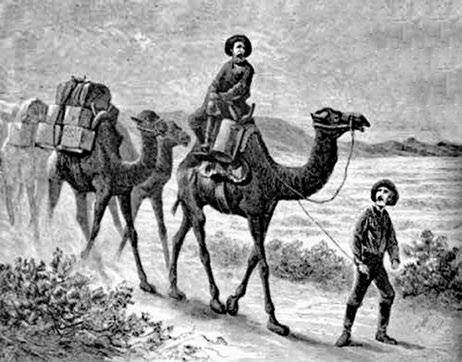
By 1853, Davis became Secretary of War, and he continued his interest in the use of camels for military purposes in the Southwest.
Again, Congress failed to appropriate any money for the purpose. Davis renewed his resolve.
Davis pointed out that the special characteristics of the Southwest–its vast stretches of arid desert–called for an animal better equipped for such travel than the horse or mule. He began to gain support from government officials and the general public.
According to an article in The Sunday Oregonian, on July 19, 1970, these were not the first camels to be brought to the New World from the Old, from where they had migrated from North America to Asia across the Siberian land bridge, before the Ice Age.
About 1550 the Spanish tried camels in Peru and a number of them were brought to Virginia in 1701. For unknown reasons, both experiments failed.
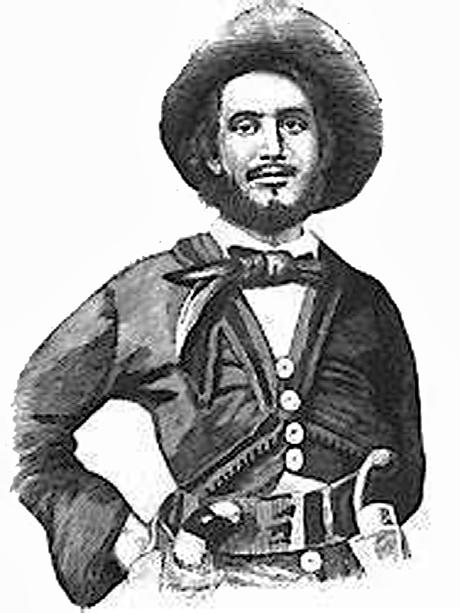
turned into Route 66 and victory in the Mexican-American War.
The survey incorporated an experiment from the Army, to use camels instead of horses, to survey the region.
The camels proved to be hardy and well suited to travel through the desert region.
Since the camel was called “the ship of the desert” in the Sahara, in theory camels should prove equally worthwhile in the American Southwest.
Camels were capable of traveling for days without water and could thrive on desert forage as the wagon road was surveyed.
Texas was about to come face to face with the United States Camel Corps. Camp Verde, Texas, a Calvary post, became camel headquarters.
Major Henry Wayne and Lieutenant David Porter were put in command of securing the camels from the Middle East.
Unfortunately, the camels were apparently not eager to prove their worth.
It was late August of 1856 when this first group of camels finally arrived at Camp Verde. The second load of 40 animals arrived during the spring of 1857.
Beale created a popular trail that allowed new settlers to reach the high desert and the valley below.
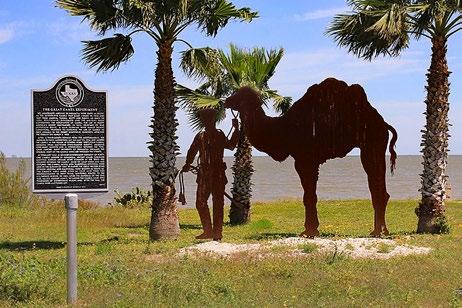
In Washington, there was another man who was jubilant over the coming camel expedition.
Henry Constatine Wayne could barely restrain his delight as he read the official letter from the Secretary of War.
Lieutenant Edward Fitzgerald Beale, who crossed the continent several times, carrying government dispatches, believed the importation of the beasts of burden should be attempted.
In 1857 President James Buchanan appointed Edward Beale to survey and help establish a trade route along the 35th parallel from Fort Smith, Arkansas, to Los Angeles, California.
Beale was a multi-faceted frontiersman who was a war hero, explorer, spy, diplomat and rancher who had a hand in the Gold Rush, creating the road that eventually
The camels arrived in the US at Indianola, Texas on April 29, 1856. When the Army Corps of Topographical Engineers imported 34 camels to survey the wagon road from Albuquerque to Los Angeles the mule lobby in Missouri had a meltdown.
“Camels,” some scoffed, “were illtempered, stubborn and ugly, had bad breath and wouldn’t learn English.”
However, during a 60 mile endurance race between mules and camels, the camels won by an impressive margin yet ultimately were ditched.
“Hi Jolly” of Syrian and Greek heritage, also known as Hadji Ali and Philip Tedro, accompanied the camels to the New World.
According to the National Archives, other drivers who were dubbed with “American” names were Greek George
(George Caralambo), Long Tom (Hagiatis Yannaco), Mico (Mimico Teodora) and Short Tom (Anastasio Coralli).
Michelo Giorgios, Yanni Illiatio and Giorgios Costi were also drivers.
With the help of Hi Jolly, Greek George and others, Major Wayne began training many disgusted Cavalrymen to be camel handlers.
Once in the desert, camels would plod along peacefully, led by their Texan and Syrian guides. Suddenly becoming uncontrollable, they would squeal, kick, bite, then take off across the desert.
In addition to their repugnant odiferous capabilities, camels were stubborn, mean and difficult to handle.
They sometimes killed mules and even attacked their handlers. They also had a habit of spitting a vile substance in the faces of those they disliked.
Horses and mules went insane with fear when they smelled a camel. They could be taught to tolerate them but there was never really an amicable relationship.
The Camel Express reached from San Antonio to Los Angeles.
When Beale left on his wagon-road survey in 1857, he took only 24 of the government’s herd of 71 camels. The rest of them were left at Camp Verde and continued to be used to carry supplies.
Lt. Beale wrote in one his reports that he’d rather have one camel in the desert rather than four of his best mules.
He spent four years exploring and surveying the deserts of the Southwest with his camels.
The large two-humped Bactrian could carry 600-700 pounds, twice the load of a pack mule, and travel 20-30 miles a day.
No grain or hay was needed, as the camels enjoyed devouring greasewood, sagebrush, cacti and most other desert vegetation they foraged with gusto. If necessary, they could travel for a week without drinking water.
In 1861 a party working for the federal government made a reconnaissance from a line from Fort Mojave, a few miles above Needles, California, to Owens Valley, 270 miles north-northeast of the then small community of Los Angeles.
The data was used when the boundary between California and Nevada was surveyed and established.
Four camels and two camel drivers were assigned to the party, which went through rugged territory, including Death Valley.
The pack mules suffered in the grueling conditions but the camels literally took it in stride.
The Civil War proved to be the straw that broke the camel's back. There were over 50 camels in residence at Camp Verde when the war between the states erupted.
During the winter of 1861, Camp
Verde was captured by the Confederacy. When the camp was recaptured by the US Government in 1865, there were more than 100 camels.
Some were rounded up and sold. Others were eaten by Apaches but the majority were set loose along the Gila River. The last camel was seen there in 1875.
Beale would go on and buy some of the camels and keep them at his ranch in Fort Tejon, California.

Beale founded the Tejon Ranch as we know it between 1855-1866 when he purchased four Mexican land grants that totaled 270,000 acres—real estate roughly equivalent in size to metropolitan Los Angeles.
In November 1863 thirty-four camels were moved from southern California to the Naval Arsenal at Benicia, where they were sold at auction on February 26, 1864.
Camp Verde was abandoned on April 1, 1869, thus ending the Great Camel Experiment.
Beale’s survey was used as the basis for Route 66, the Santa Fe Railroad and Interstate 40.
Route 66 was paved and officially opened on November 11, 1926, with road signs erected the following year.
U.S. Route 66 or U.S. Highway 66 is one of the original highways in the United States Numbered Highway System. It ran between Chicago and Santa Monica.
The scenic section of Route 66 through the Cajon Pass was replaced by Interstate 15 by 1971.
The Interstate system continued to gradually bypass sections of Route 66, with the last section through Williams, Arizona, being bypassed by I-40 in 1984, leading to the official decommissioning of the highway in 1985.
Interstate 40 replaced much of Route 66, particularly through the desert between Barstow and Needles, California.
Many sections of the old road were preserved and are still in use today as city thoroughfares and pieces of rural highways.
From San Bernardino to the Arizona state line US 66 followed the old National Old Trails Highway.
The old highway veers away from I-15 between Victorville and Barstow, following the railroad through Oro Grande, Helendale, and Lenwood.
Through Barstow, it is Main Street.
In the Inland Empire, Route 66 is Foothill Boulevard. Stay vigilant. You never know when a camel might pop up. Even if it’s just in your imagination.
Recommended Resources:
• https://www.thedesertway.com/route66-camels/
• Beale’s journal of the wagon-road survey from Fort Defiance to the Colorado River, House Executive Document No. 124, 35th Cong, 1st Sess., Washington D.C., 1858.
• Blair, Brenda, Because of the Camels, Siwa Publishing, Austin, Texas, 2012.
• Emmett, Chris, Texas Camel Tales: Incidents Growing Up…, San Antonio, Texas, 1932.
• Fowler, Harlan D., Camels to California, A Chapter in Western Transportation, Stanford University Press, published 1950.
• Lesley, Lewis Burt, Uncle Sam’s Camels, Cambridge Mass., 1929.
• Luther, Joseph, Camp Verde Texas Frontier Defense, History Press, 2012.
• Report of the Secretary of War Respecting the Purchase of Camels for the Purpose of Military Transportation Senate Executive Document, No 62, 34th Cong., 3rd Sess., Washington D.C., 1857.
• Yancey, Diane, Camels for Uncle Sam, Hendrick-Long Publishing Company, 1995.
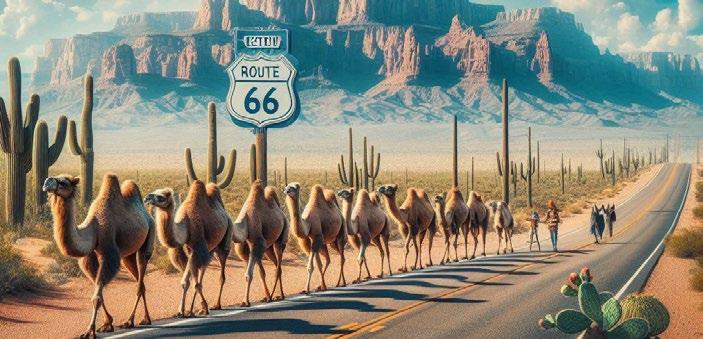

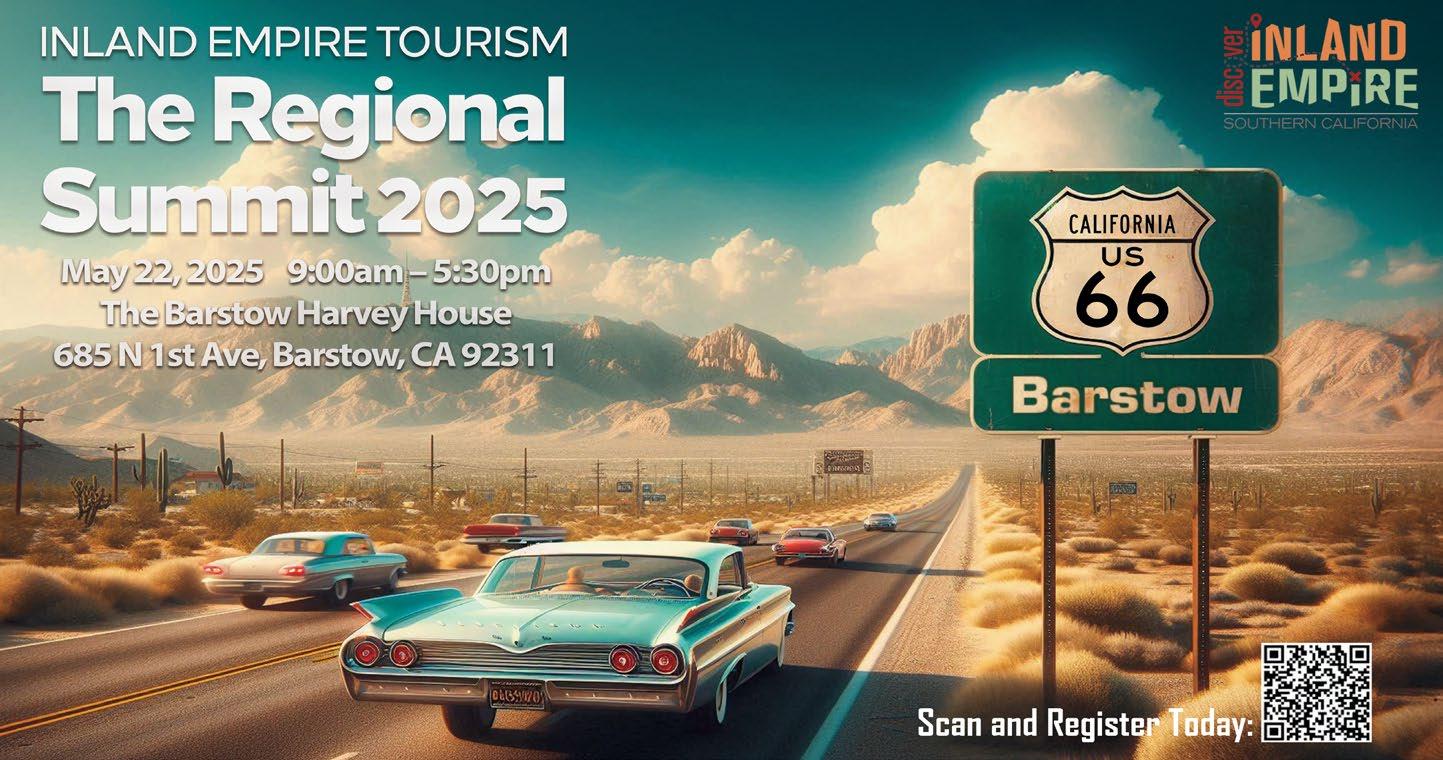
Thursday, May 22, 2025
9:00am - 5:30pm
The Barstow Harvey House - California Route 66 Mother Road Museum 685 N 1st Ave, Barstow, CA 92311
"The Inland Empire’s Only Official Annual Tourism Conference and International Marketplace"
Inland Empire Tourism: The Regional Summit 2025 will gather over 300 attendees, including Discover IE members and partners, travel industry suppliers, buyers, media representatives, airports, tourism bureaus, local cities, tribes, and leaders from federal, state, and regional communities. Key topics will include:
• State of Tourism
• Route 66 Centennial Celebration
• LA28
• China Market
• Best Practices for Regional Collaboration
• Economic Benefits of International Tourism for Local Businesses
Our lineup features guest speakers from Visit California and more. Additionally, the conference will include a Marketplace to facilitate networking among destinations and suppliers with high-profile leisure and business travel buyers, tour operators and meeting planners from the U.S./Canada, LATAM, and APAC regions. This Marketplace will help build business relationships and foster revenue generation opportunities.
Don't miss this exclusive opportunity to network with Route 66 community leaders and over 60 international leisure and business travel buyers at the Marketplace! Join us for a special tour of The Mother Road Museum, car show, food, drinks and karaoke - endless ways to play on California's Route 66!
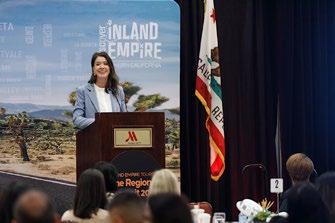
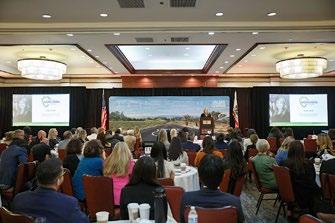

THE AUTHOR ROBERT LOUIS STEVENSON stated; “I travel not to go anywhere, but to go. I travel for travel’s sake.”
I find myself in that same mental state quite often. Of course, my lovely wife Laureen may believe I might be in another state of mental wellness - but I’ll keep that between myself and the little green men inhabiting my cranium at this time.
Driving north or south Highway 395 is always a joy. Small locales like Randsburg, Lone Pine, Bishop, and others come to mind but often it is right off the welltraveled highway to the byway where other adventures await.
Recently I took one of those byways and made my way to the ghost town of Garlock, approximately nine miles west of Randsburg.
Ghost towns are wonderful experiences for the visitor. To wander where folks had made their hopes and dreams come true, even for a short period. We humans have this endearing quality that makes us believe in our dreams and pursue them. If we hadn’t, the moon would still just be a large bright thingie that circles our earth.
I first heard of Garlock years ago during a conversation I had been having with another traveler. But honestly when the gentleman mentioned it to me years ago, I actually thought he was talking about garlic - he had a lisp in all fairness.
“I use a lot of garlic, that’s why we don’t have vampires around our home,” I replied.
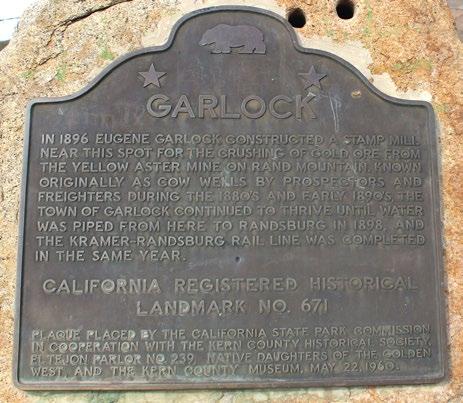
By John Beyer
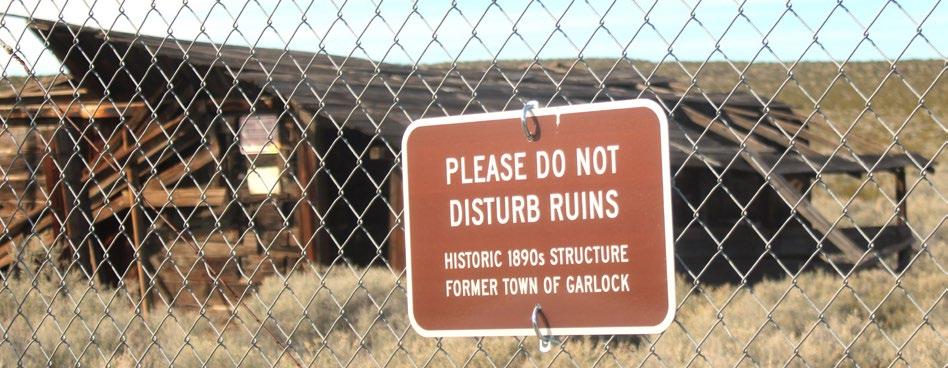
He looked at me, shook his head and walked away.
“Seriously,” I said. “Not one.”
Taking the advice from my fellow explorer, I decided it was time to actually visit the town in Kern County.
The ghost town has a very interesting history, as do most places, but this one was created for the benefit of other small towns nearby.
Garlock was originally known as El Paso City, after the small mountain range nearby, and then later as Cow Wells, since this is the area where many cattlemen and freighters would stop to obtain water for their cattle. The only other local place available was the wash of Red Rock Canyon which could be very dangerous during certain times of the year - especially monsoon season.
In the late 1880s some small traces of gold were discovered in the El Paso range and then in 1893 a gold nugget worth $1900 was found near Goler Heights and the rush was on. That amount would be approximately two gazillion dollars today. No wonder prospectors were tripping each other with their picks and shovels.
“That’s my claim,” one prospector may have yelled at another as he raced flatfooted across the desert landscape in search of his riches.
With an evil laugh, the other prospector stretched out his shovel. “And I claim you just done fell down on your noggin.”
In 1894, gold was being located all over the place and Eugene Garlock, a very successful businessman who was living
in Tehachapi at the time, decided that it would be a good venture to set up a stamp mill in the growing small town.
And that’s what he did.
An eight stamp mill was built and miners from all over the territory utilized Garlock’s ingenuity. In fact, the town started to have name changes - first miners would say they were going to the ‘Garlock Mill’ then ‘down to Garlock’ and finally just to ‘Garlock.’ The name stuck and the previous ones went the way of the desert sands - blowing into the wind.
A historical marker erected in 1958 allows the traveler to know how important this once booming town once was: ‘NO. 671 Site of the Town of Garlock. In 1896, Eugene Garlock constructed a stamp mill near this spot to crush gold ore from the Yellow Aster Mine on Rand Mountain. Known originally as Cow Wells by prospectors and freighters during the 1880s and early 1890s, the town of Garlock continued to thrive until 1898 when water was piped from here to Randsburg and the KramerRandsburg line was completed.’
A very important part of the history of this whole area, and worth a look around. There’s not much there, but that isn’t always the point when venturing into an unknown destination. Just walking over ground that others in the past have tread is worth the effort of getting there. To take in a vision they had for their future and wonder what it was like in their past.
Most of the time, it is humbling.
I once met a person who asked why I would want to visit old ruins of a bygone
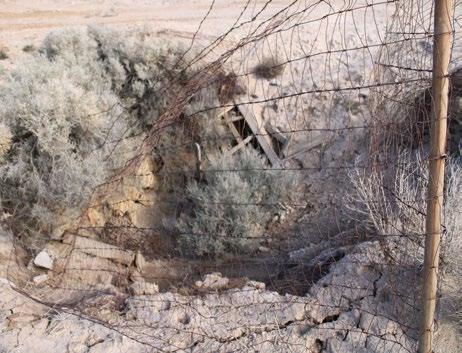
civilization - I happened to be on my way to Greece at the time and could not wait to walk where Socrates or Plato sat and thought.
“Humanity’s past is what made our present,” I responded.
“What's a humanity?” she asked. As I looked across where the town of Garlock once stood, I realized that the people who had lived here had created a life not only for themselves or their families, but for the surrounding communities as well.
It was mid-morning when I found myself treading across Garlock Road investigating this and that of what was left of this town. As I stated earlier, not much, but there are signs which tell the history of the place as well as ones that tell the onlooker not to trespass across the chain link fences guarding the few remaining original structures.
But, unfortunately one building had been graffitied with the typical nonsensical scrawling’s of a person desperately hoping someone can figure out who had been there.
Since this is a family newspaper, I will not write what kind of person would desecrate a historical site in my opinion.
The other structures are intact, though years and weather have taken their toll - as those same years and weather have taken their toll on the guy typing this column.
One area, behind a locked fence, seemed to be that of the original arrastra that was built during Garlock’s time to crush the ore on the premises.
No one was present. In fact, not a single vehicle cruised by the entire time I was wandering around admiring the ruins available to see. Then again, right off of Highway 395, there were signs and a road block stating that Garlock Road was closed due to flooding.
Being a professional, I traveled the roadway to investigate if it were true. Nope, it was not. The road was dry as a bone, but caution should be taken when ignoring road signs. In fact, it is always better to take caution seriously since in the desert flash floods can occur at a moment's notice.
I did not tell Laureen I had abandoned logic on this venture.
Garlock had a functioning post office from 1896 until 1904, and then again from 1923 until 1926. The building which
housed the government business was made out of railroad ties and can still be seen today, with a flagpole still standing proudly - absent the flag.
Though the town did boast a population of several hundred during its heyday, delivering water and crushing ore and offering other services, soon other issues would spell its doom. In 1903 a stamp mill had been built in Randsburg and water had been piped to Randsburg and other close locations since the late 1880s.
Eugene Garlock passed away in 1907 and the town seemed to drift away as well into the pages of history.
A school had been built in Garlock utilizing adobe for the walls. Later this structure was a store and rumor has it in the 1920s it may have served as a brothel and speakeasy for the local miners still managing to pull precious ore out of the ground in the nearby hills.
According to various sources, Roberta Ruth ran a curio shop in Garlock until the 1960s.
I ate lunch along the Redrock Randsburg Road and almost could hear the old wagons creaking by carrying water east toward the bustling mining town of Randsburg. It was probably just the slight breeze in my ears.
Then again . . .
John can be contacted at: beyersbyways@gmail.com
By Cindy Bostick
AT TODAY’S WOMAN FOUNDATION (TWF), we believe that no woman should face cancer alone. Through our Bundles of Hope project, we offer more than care packages—we offer love, encouragement, and the reminder that community is a powerful source of healing. This week, we had the rare and beautiful opportunity to witness the impact of a bundle being received. Tammy, who is currently undergoing cancer treatment, was visibly moved as she opened her box. The look of awe and joy on her face said more than
words ever could—it was a reflection of hope, of being seen, and of knowing she’s not alone.

Each Bundle of Hope is thoughtfully filled with comfort items, inspirational messages, and small essentials designed to lift a woman’s spirit during one of the most vulnerable times in her life. But beyond the contents, the care makes these boxes special—care from dozens of volunteers who lend their hands and hearts to this mission.
TWF has distributed over 1,200 Bundles of Hope to women throughout the High Desert community. Every single box is a testament to the strength of unity, compassion, and collective kindness.
To all the volunteers who paint, decorate, pack, personalize, and deliver these gifts—you are the heartbeat of this project. Your time, touch, and belief in lifting others make all the difference. And to the women receiving these boxes—may you feel
surrounded by strength, love, and a caring community.
Because hope is a gift worth sharing— and at TWF, we’re honored to deliver it, one Bundle at a time—in the face of cancer. Explore www.todayswomanfoundation. org to learn more about all we do.
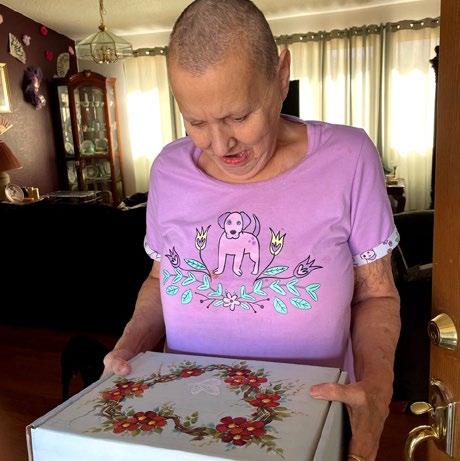
By Tiffanie Williams
TUCKED AWAY in the heart of Lucerne Valley lies a sanctuary unlike any other—a place where visitors can lock eyes with wolves, feel their energy, and support their continued care. Wolf Mountain Sanctuary is one of the area’s best-kept secrets, and now, as the weather warms, they’re opening their doors for the spring and summer season.
The sanctuary is currently booking tours Wednesday through Sunday at 10 a.m., 11 a.m., and noon. These intimate experiences allow guests to meet the wolves up close and personal—a rare and unforgettable opportunity. But with fewer tours this year, the sanctuary is facing financial strain and is asking for the community’s help.
Wolf Mountain Sanctuary is considering hosting a fundraiser to support the animals, with street tacos, beans, rice, and an allday celebration in the works. While a
date hasn’t been finalized, excitement is already building.
In the meantime, guests are encouraged to book tours and spread the word. Greeting cats Rambo and La Victoria welcome visitors upon arrival and will guide you to the store to check in—setting the tone for an experience filled with love, purpose, and wild beauty.
The Lucerne Valley Chamber of Commerce is urging the public to support this unique nonprofit by scheduling visits and sharing the sanctuary’s story. Every tour helps provide for the wolves and supports the team’s mission to educate the public on their importance.
To schedule your visit, call (760) 2487818 and be a part of something wild, meaningful, and truly local.
https://www.facebook.com/WolfMountainSanctuaryOfficial?mibextid=wwXIfr&mibextid=wwXIfr

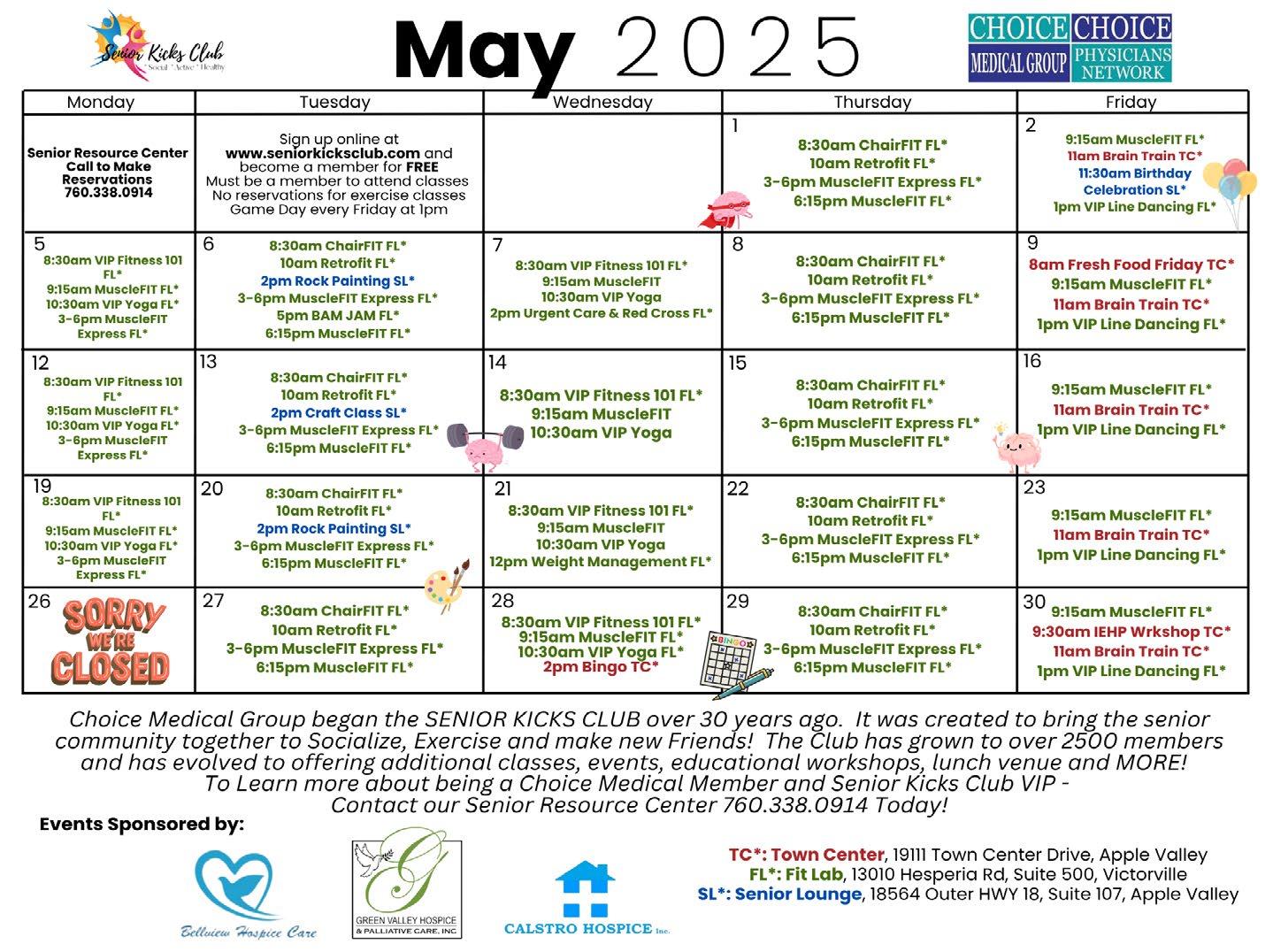
By Tiffanie Williams
JUST OFF THE BEATEN PATH IN PHELAN, California, nestled between rugged desert brush and the backdrop of the San Gabriel Mountains, is a place where adventure comes to life: Forever Wild Exotic Animal Sanctuary.
This hidden gem isn’t your typical zoo. It’s a rescue sanctuary with heart— dedicated to saving, rehabilitating, and giving lifelong care to exotic animals that were once abused, abandoned, or illegally kept as pets. From majestic tigers and bobcats to playful monkeys and aweinspiring reptiles, Forever Wild is home to over a dozen species that now have a second chance at life.
Visitors can take guided tours through the sanctuary, where they learn each animal’s
story, how they were rescued, and the importance of wildlife conservation. You might find yourself locking eyes with a lion rescued from a backyard cage or watching a zookeeper feed a curious kinkajou.
“We’re not just a place to see animals— we’re a place to learn, feel, and connect,” says sanctuary staffer Amanda Rivera.
“Every animal here has a story, and we’re honored to share them with the community.”
Forever Wild also offers special feeding tours, educational field trips, and private events, making it a must-see for both tourists and locals alike.
As Phelan continues to grow as a destination within the Inland Empire, Forever Wild stands as a reminder that sometimes the greatest adventures aren’t
far from home—they’re just around the corner.
Location: 8545 Buttemere Rd, Phelan, CA
https://www.facebook.com/foreverwildsanctuary?mibextid=wwXIfr&mibextid=wwXIfr
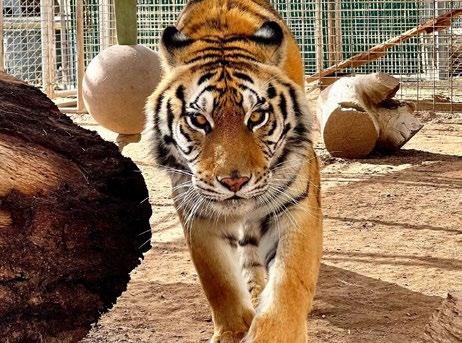








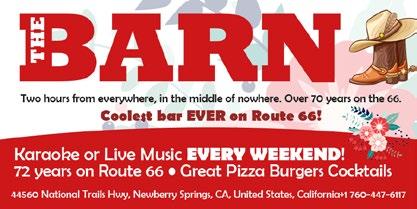






By J.P.Garner
WE EACH ARE GIFTED in some way. Be it painting, music, or even brain surgery, we each do something so well as to stand apart from others. If you’re good at a lot of things, you’re called aa renaissance man . . . which calls to question, is there such a thing as a renaissance woman? Doug E, Sunshine is good at guitar. He’s very good. He was born in Whittier but bounced around in his youth from Prescott, Arizona, to Montgomery, Alabama and then to Humble, Texas, right on Lake Houston where, as he recalls, “I started getting into music. I heard Van Halen and saw that stuff, it was like, holy moly. My cousin had a cheap old guitar with two strings on it, and I saw him play. I said, whoa, I thought it was the coolest thing ever.
“And so I bought my first guitar . . . Japanese, late 60s something, and it was barely playable, but that’s what I learned on. And then, I was just excited, you know, it’s like every night I would sit in my room learning new stuff and sometimes doing my homework. As soon as I picked it up, Smoke on the Water came out.” He laughs. “Yeah . . . that’s the first thing is everybody plays. But, it just escalated from there. I wrote down the songs that I learned the first week and then the second week, well, I knew how to play 16 songs.”
A child prodigy? Maybe. If you consider thirteen a child? Elton John was eleven when he won a scholarship to the Royal Academy of Music. But Doug E was, he remembers, in eighth grade. Synonyms for the word, prodigy, are “genius” and “phenomenon.” And while he was a little older than Mozart and Elton John, an argument can be made that it’s not so much when the discovery occurred that counts, but how quickly a specific skill is acquired.
Two weeks is pretty quick.
When at fifteen he came back to California, his uncle built him a guitar. “I had a cheapo guitar and I wanted something custom cool that nobody else had, [And I got into] hard rock, heavy metal bands like Iron Maiden, Judas Priest, and Rush . . . that was one of my favorites. And I learned
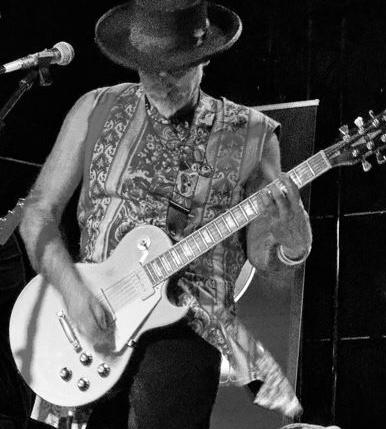
a bunch of the Led Zeppelin songs and stuff like that. But, as a guitar player, I was into learning stuff.
“But the funny thing is, when I started getting older, a lot of my influences that were like in the back of my head that I didn’t even know were there, came from my parents who used to listen to Barry Manilow and Abba, and some really old country guys from the 60s and stuff my dad would listen to, like Nat King Cole. And all that stuff was in the back of my head, but I never tapped into it because I didn’t get it yet.
“So, in the late 80s to the early 90s, I was in a band called Fault Line up here in the High Desert, and we played for like five years the first time around. And immediately we wrote eight songs within a couple of months and we’re out playing them. Man, we were tight. Most of my guitar solos I wrote and I was 19-yearsold.
“When I go back and listen to it, my chops were like shredding, Like a trapeze act, you know? Very melodic. I just overplayed. It was years later I realized that, oh my god, what was I thinking playing like that? Everything had to be a hundred miles an hour.”
Doug E grows silent. He’s clearly thinking about those days in the band and how music from various genres shaped him, and how he was unaware of some of the older influences coming from his
dad. “Every one of my influences was a stepping stone for me to add pieces of what they did to my playing. That way, it’s like extra ammunition where I wanted to be able to get into any situation, whether it’s rock, metal, jazz, country, any of that, and just be able to just fit in. Even though I was like, not a jazz guitar player, not a Brad Paisley country guitar player, not this guy, you know, I just wanted to be able to add enough if I happen to find myself in that position.”
But here’s the weird part. It has to do with a major influence in Doug E’s learning curve. What he, as a crafter of music, learned from someone who was, as put he put it, “outside the box.”
“Most people know who Dream Theater is and John Petrucci, their guitar player. The first song [of theirs] that I heard was mellow, and they’re a metal band, but they’re like a progressive band too. ‘Holy crap, I thought. Who are these guys?’ This is a beautiful song!
“But John Petrucci, himself, never really influenced me until I saw his live solo. He starts going into these jazz tangents, and I’m thinking, ‘Whoa, rewind that! What the hell is he doing there? It’s twisting my ears. Throwing all these jazz riffs in the middle of his solo. I learned that whole solo section, and then I started slowly working my own and learning my own music theory. I was teaching it to myself with jazz modes.
“And then 10 years after that, I started using my fingers doing the Brad Paisley stuff and learning how to do the little chicken picking stuff. I hadn’t written any songs for, golly, 20-25 years maybe until like 2018, I started [writing again.”
Time became a concern. How much of it was left. Writing was his passion but not lyrics. Just the music. He was the guy who played the rhythms and shreddy solos and he’s sing harmonies, but he never had any intention of being a front guy. He explains that, “even when I was young, I could never memorize anything. Lyrically, nothing. I’d cheat in class and have somebody hold up a poem so I can read it from the podium, you know, because I couldn’t even memorize two lines. I’d get up there and freak out.”
But his voice wasn’t great for singing.. It wasn’t even seasoned. He could sing harmonies with anybody. He could hear what’s not there and figure out all the orchestration. So, up for challenge, he put in the work to get better. He started recording songs and then it was on his phone. “I was singing into the phone. And that’s still one of my favorite recordings to this day. It’s on my YouTube channel. There’s a couple of them where I sang and played acoustic guitar into the phone.
“I was working on cars at the time, and I’d be doing timing belts and brakes and everything else, and song lyrics are going through my head. Sometimes I had three papers out, writing three songs all at the same time, with different rhythms. And every song that I write is completely different.”
Like the great bands, Doug E loves to experiment. He’ll dig deep into all the old influences like Neil Diamond and Jeff Lynn from ELO and all those big songwriters in the 70s and even some of the 60s will come into play. A little shading of something that wakes the song up and takes the listener on a rollercoaster ride that ends with a big note . . . a boom.
“I got together with Fault Line again under a different format, and Desert Rain was another band that I was in. And we had two albums with original music. But playing in two bands, working full-time, was {too much] and my body was falling apart, okay, and I’m making the show bigger at the same time. So now I’m starting to add my lighting, build the big lighting snakes and build in my own lighting pedal board, you know, and then starting to bring the keyboards. So when I record music, all the instruments you hear, I play.
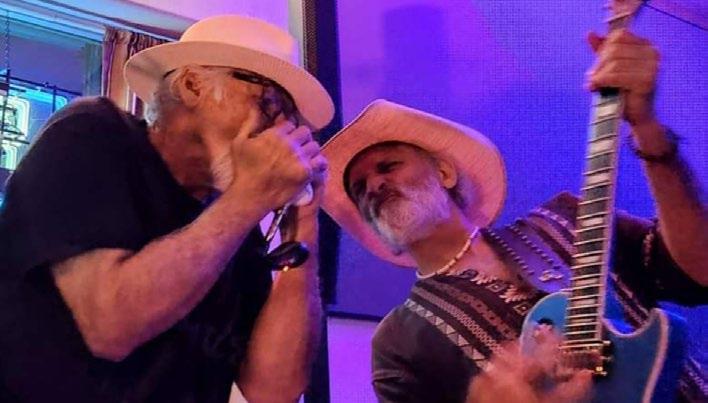
“I don’t write music as a guitar player. I write music like for an orchestra or something For me, it’s such a deep passion that I want to be able to move to the next level. I want to work on this fast guitar riff even if I never use it. It’s just my own personal thing; just so you can master it. Yeah, so just so it’s in my repertoire. You’re not a show-off anymore. You’re an artist.”
At the end pf 2011, after playing a New Year’ Eve gig, he’s driving home and he said, "That’s it. I can’t do it anymore. It’s done. I’m all worked up here. I’m pissed off all the time. You know, this isn’t fun anymore." And so, and my body hurts, my back was so sore, my knees after the first set, man. I mean, I was falling apart. And so, and I never even drank any alcohol or nothing back then, you know? So, I called both bands the following week and said I can’t do it anymore. I had to find a new Zen.
“So, every morning, I would drive to work in complete silence, no radio. And I would just drive in my comfortable truck, nice and quiet. And I would never listen to music. I didn’t, I still to this day really don’t listen to much music. It’s kind of weird, because I’m always just doing stuff. And I don’t really, I don’t turn the radio on ever in a car, you know? And so, even me and my wife will go on a trip. Drive a thousand miles, never turn the radio on.
“It took me nine months of trying to find my inner peace, before I started calming down. But during that time, that’s when
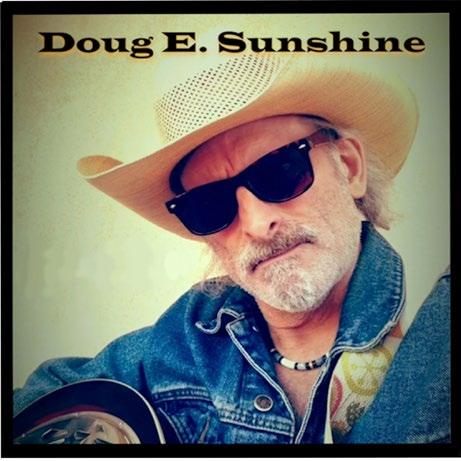
things changed too, because I still had that deep love in my heart for playing music. I started getting into the mandolin and Native American flutes and all kinds of [instruments like ] Irish tin whistles and the violin. I started branching out to all these acoustic alternative instruments, instead of guitars, drums, rock bands”
.
“So, I pretty much do my live show and have whoever’s available to play with me. These days, it’s Dale and Doug and I’ve got Cat Douglas, who’s a good singer but she just needed coaxing in the right direction. I’ve been teaching her to be a great singer! We’ve been to the Dream Lounge a lot, and Cafe 247. I don’t want to do cover tunes. I mean, I like the songs that I bring in, but at the same time, we focus on my stuff. So when we have to do a two to three hour show, you know, my songs are still number one, and then we lace the cover tunes in between. So even if we bring out a Journey or an R.E.O. Speedwagon, I can lace my songs in the middle there, and it’s like an elevated thing,” Right now, he’s in the middle. He’s never been a self-promotion kind of guy because he was always just one of the players in the band and somebody else was always collecting the money and getting the gigs and doing this and that. Even still, he dropped his first single on Spotify on January 24th and he’s working on bigger shows to promote his music. “I don’t care about being a millionaire,” he says in closing. He’s sincere. It comes from what he’s gone through to get to where he is. The challenges. The work and discipline. His love of making music. “I just want people to hear my music somewhere other than the High Desert and maybe enjoy it. Because sometimes when I hear my music, I don’t believe I wrote that.”
The songs that end on a BIG note . . . a BOOM.

Friends of the Apple Valley Library
14901 Dale Evans Parkway Apple Valley, CA 92307
Tuesday, May 13, 2025 from 11:30AM - 1 PM
Speaker: Barbara Betterley
Topic: The History of The William A. Betterley Western Heritage Foundation
Victorville Senior Citizens Club
Mother’s Day Tea Party
May 9, 2025
Open to Public BINGO
April 26
May 10 &; May 24, EVERY 2nd &; 4th SATURDAY
PAY OUT $75 to $200
Open to Public
Bid Whist Tournament
May 31, 2025
$10 in Advance and $12 at Door
Open to Public Call to for information how to become a member
Exercise: Monday-Thursday 10am-11am
Line Dance: Monday & Thursday 11:15am-1:30pm
Poker: Tuesday 10am -3am
Soul Line Dance: Monday & Wednesday 9:15am
Bid Whist: Thursday 11am-2pm
Pinochle: Friday 10am-3pm
Victorville Senior Citizens Club
14874 S. Mojave St. Victorville CA 92395
760-245-5018
May 1 Rattlesnakes - Norman Bossum
May 8 Mad Libs For Seniors - Debbie Walker
May 15 Senior Kicks Club - Katiann Hutchins
May 22 Bee Keeping - Sue Nolan
May 29 What Happens When You Call 911 - Al Jackson

May 3, 2025 58th ANNUAL BBQ & OPEN HOUSE Delicious BBQ Served From Noon to 4pm, Special Events all Day! Call 760-256-5452 for more information
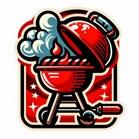
Seniors With Inquiring Minds (SWIM) meets every Thursday from 1:00-2:00 PM in the Percy Bakker Community Center located at 9333 Avenue “E” In Hesperia, CA 92345
DISCOVER INLAND EMPIRE, the official destination marketing organization for San Bernardino and Riverside Counties, organized a VIP tour for a Japanese press group. The group of seven included Mr. Soichi Kageyama, chief editor for “Daytona” and “Setagaya-Base” magazines. Both are car and lifestyle magazines with a combined monthly circulation of 80,000. Also in the group was Mr. Kota Takeuchi, editor for “Auto Messe Web,” an online car and lifestyle magazine with 17,000,000 page views each month. Ms. Izumi Ashikari, is the editor of “All About” and “Lighthouse” online magazines, both popular with thousands of Japanese residents of Southern California. Mr. Satoru Nakayama is the editor and Youtuber for “Tracy” and “Ask,” online information and IT magazines.

The tour was planned as a two-day event. The first day was a trip from Palm Springs to Needles. The second day was from Needles to Victorville traveling along the Historic Route 66 as much as possible. The planned stops were at Goff’s school house, Roy’s Café and Motel in Amboy, and a lunchtime arrival at the Bagdad Café. Freddy Bi, President and CEO of Discover Inland Empire contacted Rose Beardshear, President of the Newberry Springs Chamber of Commerce, to set up the tour and lunch at the café.
Rose knew just the person for this, and recommended Karla Claus, owner of Route 66 Tours and Events. Karla lives near the café and has been helping Andrea Pruett, the owner of the Bagdad Café, organize the popular tourist spot. She has been promoting the café at local events by selling the Bagdad Café and Route 66 souvenirs for Andrea. Karla contacted Freddy and was told it only required a simple meet and greet, a tour of the café, and lunch. Media gift bags for each person would be nice and could include promotional items for Newberry Springs. The potential media
exposure would be advantageous for Newberry’s Route 66 tourism.
It sounded like a win-win for Newberry Springs. There were a few issues. The date of the visit was less than three weeks away. That wasn’t much time to organize a potentially important event. Then there was lunch. A kitchen fire a couple of years ago ended food preparation at the café. What seemed impossible was just a challenge for Karla. With her energy and Newberry’s community spirit, she pulled it off.
Just up the old highway is another popular location, the Barn Route 66. Rene, the owner of the quirky roadhouse offered to serve lunch there. Knowing country western music was popular in Japan, Karla asked Ryan Bodine to entertain them while they were eating. Ryan Bodine grew up in Newberry Springs. In fact, his school bus stop was the Bagdad Café. Ryan is a rising star as a singer and songwriter. He has been on a “Hometown Tour” lately and was glad to help.
Because two of the visitors produce car magazines, Karla asked a friend with a classic car to park in front of the café. He passed the word to some car buddies and a respectable amount of classic and custom cars were lined up for the enjoyment of the press group. Two special guests were at the café to greet them as well. First, a little Bagdad Café history is in order.
The café was built in 1975 as the Sidewinder Café. In 1987, a German film director wanted to make the movie “The Bagdad Café.” The story is about a German tourist who is abandoned in the desert after a fight with her husband. Stranded, she walks until she arrives at the Bagdad Café. Bagdad was one of the many small communities east of Newberry Springs along the Santa Fe tracks where the steam trains stopped to take on water. A café in an isolated desert area to represent “an eccentric truck stop community in the middle of nowhere” was needed. The Sidewinder Café was perfect. Both special guests were actual cast members in the movie.
There is a scene in the movie where a man throws a boomerang around a water tank on a tower. The movie company decided, knowing actors, it would be easier to train a boomerang expert to act rather than teach an actor to throw a boomerang. Alan Scott Craig was hired. Alan not only was an expert at throwing boomerangs, but he was also making a living making
By John Wease
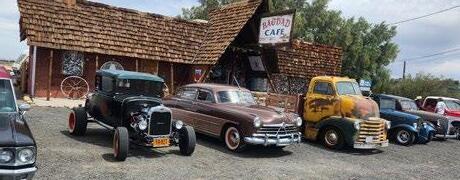
boomerangs in artistic shapes and designs. Some of his creations are on display at the café. He demonstrated throwing and gave lessons in the technique. At lunch, he demonstrated throwing his tiny business card boomerangs. Alan is available for presentations and can be reached at artofboom@hotail.com or at his website: www.artofboomerang.com.
The other cast member was Art Torres. Art lives in the neighboring community of Daggett. He is best known these days for his “Drag it to Daggett” YouTube videos. He played one of the truck drivers in the movie. His friends call him “You bet” as that was his only line in the movie. He said it very well though. Art has been in other local pictures and commercials. He worked on cattle ranches as a cowboy and was a professional rodeo cowboy in his younger days. In the longer, European film version, he drives up in his actual big rig truck. The American version cut out that scene.
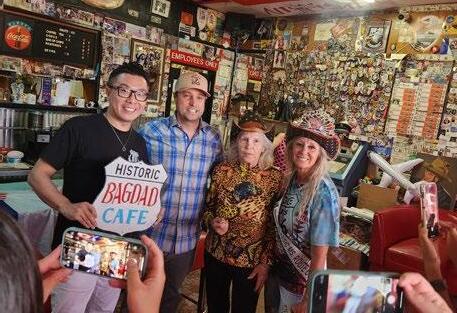
Andrea Pruett purchased the Sidewinder Café about thirty years ago and renamed it the Bagdad Café. She decorated it with movie memorabilia hoping to attract tourists traveling the Historic Route 66. The movie was not a huge hit in this country but has a near cult following in Europe and Japan. Busloads of foreign visitors can be seen arriving to see the movie set of their beloved movie. In fact, thousands visit the Bagdad Café every month in the season. It is full of memorabilia as well as tee shirts, hats, and other souvenirs. Stop by and check it out. I think you will enjoy it. The café is located at 46548 National Trails Highway. Their phone number is 760-267-6486.


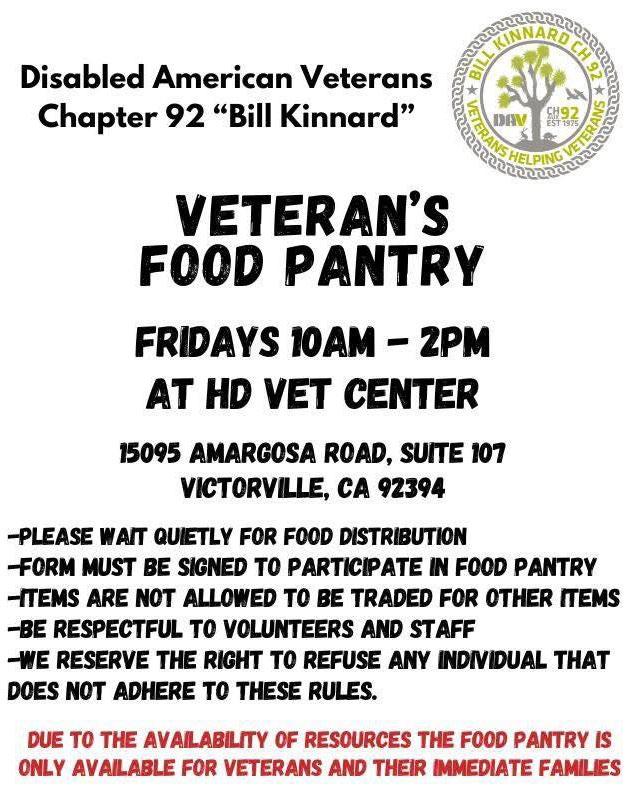

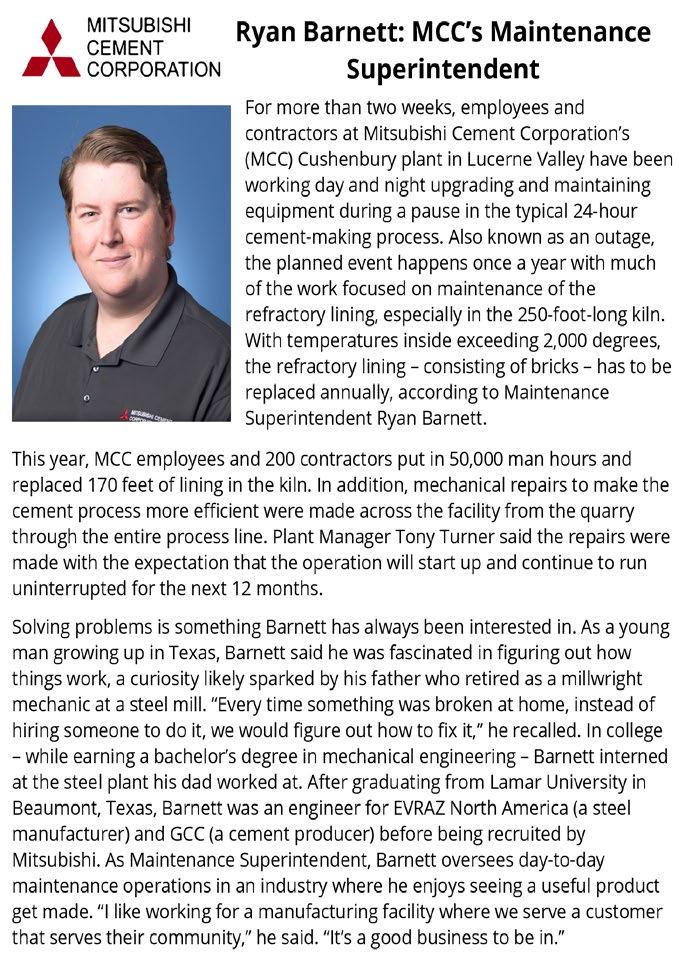
IHAVE BEEN WRITING articles for Pulse Publications for about two and one-half years. In fact, this is my fiftyninth article. It isn’t easy to come up with subjects of interest. Annual events have the problem of finding something different to write about them. Historical articles require a great deal of research to find little-known facts to add to the interest. People who know me know I am always on the lookout for something to write about. It helps to have a friend like Karla Claus. Karla is a long-time resident of Newberry Springs and active in just about everything here. She also has started her own tour business, “Route 66 Tours.” You may spot her at events wearing her Queen National Classic Miss Route 66 crown. She won a “2024 Route 66 Extra Ordinary Women” micro-grant for her start-up tour business. She messaged me on April 7 to say she had been invited to an event at the “Mongolian Camp” in Newberry Springs that afternoon and could invite anyone else who may be interested.
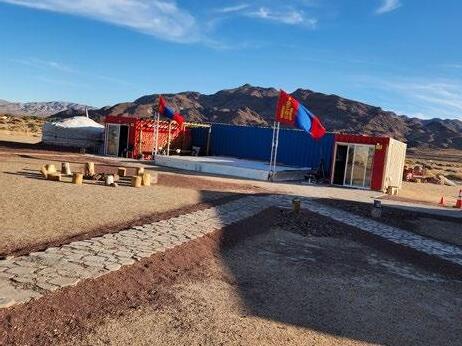
The information was a little vague. She only knew it was a campground with “Yurts” and that they would have Mongolian music and food. Yurts are the traditional, large, wooden framed tents used by the Mongolian nomads. I have seen Yurt-style tents in programs about “glamping,” where tents are glamorously furnished like fivestar hotels, and expected to find just that. It turned out to be much more authentic. It was as if we had stepped out of our car and into the steppes of Mongolia I am much too humble to think I am the smartest person in the room. I do hope I am a contender for second or third. I quickly realized I knew practically nothing about Mongolia. I have heard, of course, about Genghis Khan. I know the mounted Marines, known as the China Marines, rode Mongolian horses during their service in China. I have learned that Mongolia is a large East Asian country. At

603,909 square miles, and a population of around 3.5 million, it is the world’s largest land-locked country and the most sparsely populated.
Roughly one half of the population lives in the capital city of Ulaanbaatar. The high latitude and elevation make it the coldest capital city in the world with an average yearly temperature of 29.7 degrees Fahrenheit. About thirty percent of the population continue to live the horse-based nomadic lifestyle. Mongolia has mountains in the north and west, and the Gobi Desert covering the south. The grassland plains, called steppes, are largely used for grazing livestock. There is very little agriculture. The traditional diet is based on dairy, meat, and animal fats. Mutton is the primary meat.
Historically, Mongolia’s small tribal units were united as the Mongol Empire by Genghis Kahn in 1206. The empire became the largest contiguous land empire in history, covering twenty-two percent of the earth’s land area. His grandson, Kubla Kahn conquered China, forming the Yuan Dynasty. The Yuan Dynasty was replaced by the Ming Dynasty. In the 17th century the Qing Dynasty absorbed Mongolia. In the early 20th century, Mongolia became a satellite state of the Soviet Union and independent in the 1990s.
The event we attended was somewhat of a practice session for a large festival they plan to have in September. Most of the guests were professional Mongolian musical entertainers and their wives. Traditional music reflects nature, nomadism, and shamanism. The “long song” or “throat song” is accompanied by an instrument called a morin khuur, a Mongolian version of a cello. Some of the singers put their own modern spin on tradition. One gentleman performs “Quiza,” Mongolian rap. Western music was prohibited under communist rule. Hip hop music began in the mid-1980s as a form of protest. With 75% of Mongolia’s
By John Wease
population under the age of thirty-five, I’m guessing it is popular. Another surprise to me is Mongolian country western. One gentleman that was there was a big hit on the America’s Got Talent show.
A traditional meal was served. The host left the yurt with a portion of meat. I was told it was traditional to place a portion of the meat in the fire as an offering to give thanks to the creator. The first drink of either milk or the traditional milk-based vodka is also given as an offering. The host made a speech in Mongolian welcoming everyone followed by a toast, scotch not vodka. The culture and cuisine of Mongolia have been influenced by both China and Russia, but they have their own language. They use the same Cyrillic written language as Russia.
We were made to feel very welcome. It was fascinating to see the yurts. They are actual Mongolian “gers,” yurt being the Russian name for the domed, sheepskin covered tents. The wooden bows of the frames are either intricately painted or carved. Several are furnished as bedrooms and available as Airbnb lodging. It is camping, not a hotel. The restrooms are outside. There are kitchen facilities available. There is a lot of tranquility. It is listed on Airbnb as “Million Star Yurts.” It would be a great place to relax and watch those millions of stars.
Although it is available on Airbnb, I think their main goal is to provide a location for the thousands of Mongolian expatriates residing in this country to enjoy a tranquil respite from big-city American life and a return to Mongolian tradition. The camp is located at 44222 Tonapah Street in Newberry Springs. Their phone number is 323-344-2145.
